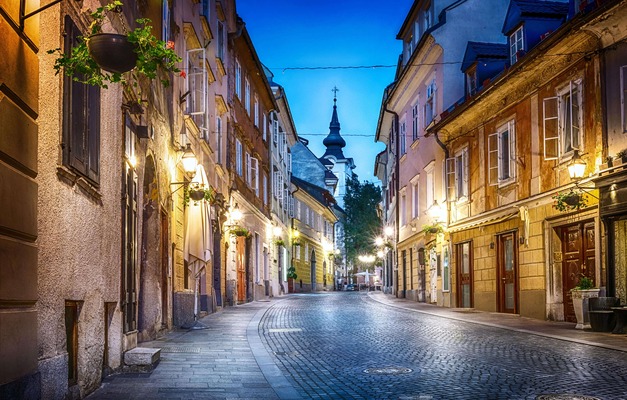
Central Europe Heritage Tour: Warsaw, Krakow, Prague & Budapest
 14 Day Tour of Warsaw, Krakow, Prague and Budapest
14 Day Tour of Warsaw, Krakow, Prague and Budapest
Overview
Trip Map
Itinerary
Inclusions
Reviews







14 Days 13 Nights
Best Time: Jan-Dec
Jewish Heritage
WWII History & Communist Era
Visit four of Central Europe's most captivating cities, admiring their stunning architecture and encountering a rich tapestry of Jewish heritage, WWII history, and medieval wonders. Experience Warsaw's resilience, Krakow's charm, Prague's grandeur, and Budapest's elegance. Take sobering journeys to the former concentration camps of Auschwitz and Terezin. Each city offers a unique blend of cultural experiences, enhanced by detailed travel guidance from Go Real Travel’s mobile app. Experience the essence of Central Europe with private guided tours and immerse yourself in the stories, sights, and sounds that make this region truly unique.
- Reflect on history at the POLIN Museum in Warsaw & visit the Auschwitz memorial from Krakow.
- Explore the historic Kazimierz Jewish Quarter and tour the legendary Wawel Castle in Krakow.
- Discover the intricate beauty of Prague Castle and stroll across the iconic Charles Bridge.
- Marvel at Budapest's stunning Buda Castle and unwind in its famous thermal baths.
- Wander through Warsaw's vibrant Market Square and admire the Astronomical Clock in Prague.
Visit four of Central Europe's most captivating cities, admiring their stunning architecture and encountering a rich tapestry of Jewish heritage, WWII history, and medieval wonders. Experience Warsaw's resilience, Krakow's charm, Prague's grandeur, and Budapest's elegance. Take sobering journeys to the former concentration camps of Auschwitz and Terezin. Each city offers a unique blend of cultural experiences, enhanced by detailed travel guidance from Go Real Travel’s mobile app. Experience the essence of Central Europe with private guided tours and immerse yourself in the stories, sights, and sounds that make this region truly unique.
- Reflect on history at the POLIN Museum in Warsaw & visit the Auschwitz memorial from Krakow.
- Explore the historic Kazimierz Jewish Quarter and tour the legendary Wawel Castle in Krakow.
- Discover the intricate beauty of Prague Castle and stroll across the iconic Charles Bridge.
- Marvel at Budapest's stunning Buda Castle and unwind in its famous thermal baths.
- Wander through Warsaw's vibrant Market Square and admire the Astronomical Clock in Prague.

Royal Castle
Castles & Chateaux

Palace of Culture & Science
Architecture

Old Town
Architecture

Schindler Museum
The Great War & WWII

Prague Castle
Castles & Chateaux

Charles Bridge
Historic Landmarks

National Museum
Museums & Galleries

Central Market
Street Markets

Castle Hill
Castles & Chateaux
Must see sights

Royal Castle
Castles & Chateaux

Palace of Culture & Science
Architecture

Old Town
Architecture

Schindler Museum
The Great War & WWII

Prague Castle
Castles & Chateaux

Charles Bridge
Historic Landmarks

National Museum
Museums & Galleries

Central Market
Street Markets

Castle Hill
Castles & Chateaux
Starting from
$2349
per person
 Not included
Not included Secure Your Customizable Trip
Enter your details to embark on a journey that can be tailored just for you.
Start
Travelers
0 travelers
Add Room
Remove Room
Preferred Hotel Stars
Select Hotel Stars
Craft Your Own Itinerary
Select your interests and destinations for a trip plan inspired by you.
Trip Map & Itinerary
Enable/Disable Map Scrolling
Click To Make Map Interactive

Trip Timeline
 Edit Details
Edit DetailsArrival
2 nights
Warsaw
Poland
Train: 2.5h
3 nights
Krakow
Poland
Train: 6h
4 nights
Prague
Czech Republic
Overnight Sleeper Train: 10.5h
3 nights
Budapest
Hungary
Departure
Day-By-Day Itinerary
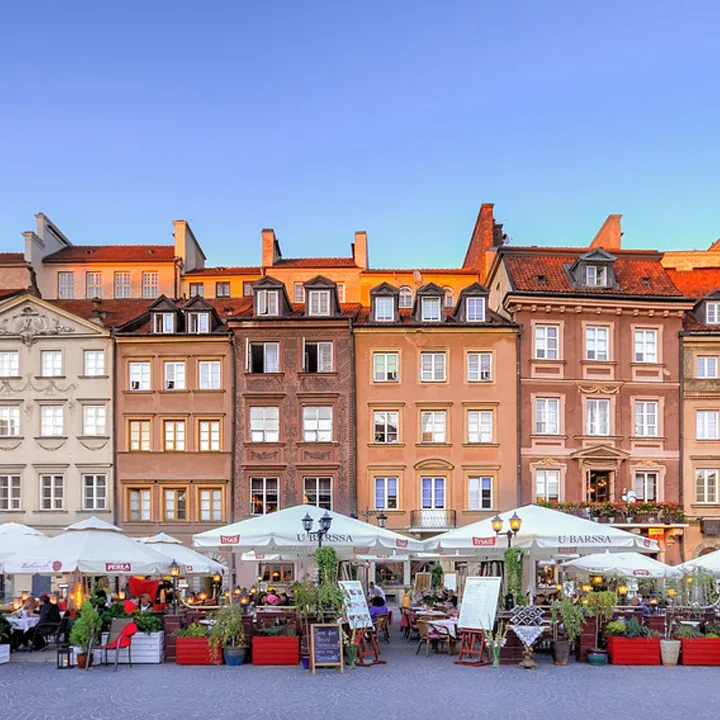
Day 1
Arrive Warsaw
Day 1
Arrive Warsaw



To Be Determined
Arrival in Warsaw Airport and Transfer by Taxi or Train
Unless flying budget airline RyanAir into Warsaw Modlin Airport, you will likely arrive in Warsaw's main airport - Chopin Airport. Taxis are available at both airports, or you can arrange a private transfer for added convenience. The cheapest and fastest way to reach central Warsaw from Chopin Airport is by train. In less than half-an-hour the S2 and RL train deliver you to Warszawa Śródmieście station, which is co-located with Warsaw Central Station in the center of the city. From there you can walk to your hotel, take public transport, or easily hail a taxi or take an Uber that will be much less expensive than from the airport. Plus by taking the train you avoid potentially heavy traffic as well.

Day 1
Arrive Warsaw


Day 1
Arrive Warsaw




To Be Determined:
Transfer from Airport
Mid-Day to Late Afternoon:
Royal Castle & Old Town
Late Afternoon/Early Evening:
Palace of Culture

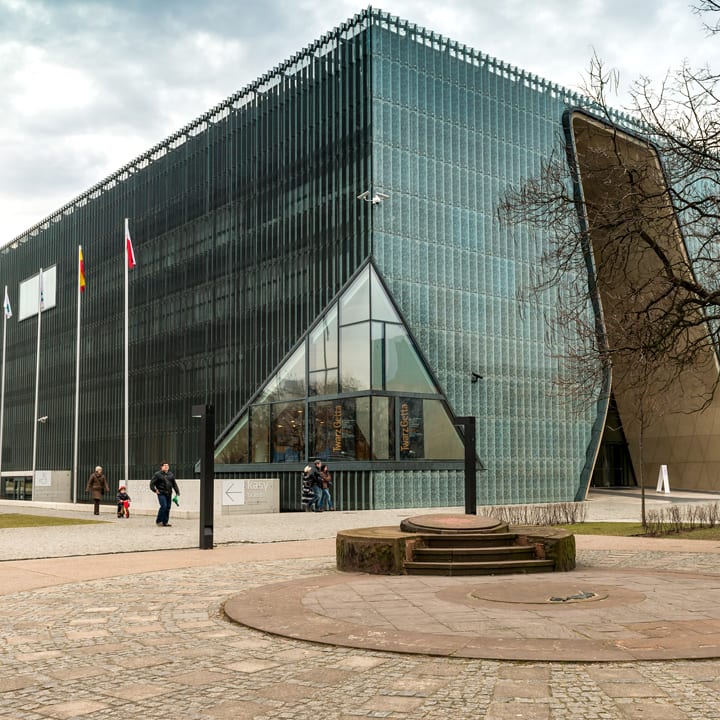
Day 2
Warsaw
Day 2
Warsaw



Morning to Afternoon
POLIN: Museum of the History of the Polish Jews
Winner of the 2016 'Oscar' for museum design, the POLIN museum is a brilliant example of the new generation of multi-media narrative history museums, and demonstrates Poland's determination to re-tell its history after decades of suppression under the former Communist regime. Built on a former Jewish Ghetto site in front of the Ghetto Heroes Monument, which memorializes the 1943 uprising within the Warsaw ghetto, the museum's core exhibition occupies more than 4,000 square meters (43,000 sq ft) of space. It consists of eight galleries that document and celebrate the thousand-year history of the Jewish community in Poland – once the largest Jewish community in the world – that was almost entirely obliterated during the Holocaust. The Holocaust fills only one of the eight galleries, and thus does not overshadow the long and rich history that preceded it. Highlights include early Jewish manuscripts, re-creations of 18th century Jewish town life (including a scale replica of the Gwozdziec synagogue with its colorful painted interior), a religious school and a busy Warsaw street from the early 20th century. All this is done using sound effects and modern projection techniques, vintage photographs and films, histories of Polish-born movements from Hasidism to Zionism, and a vast multimedia network encompassing more than 250 computer terminals. This is a museum full of noise and color; with echoes of centuries of Yiddish chatter and the soulful sounds of klezmer music. No visitor will leave unmoved.

Day 2
Warsaw


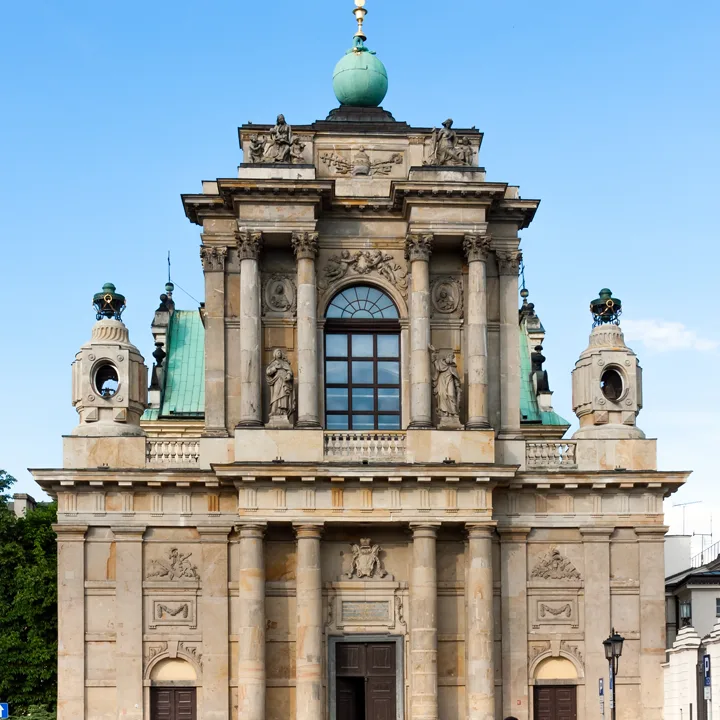
Day 3
Warsaw to Krakow
Day 3
Warsaw to Krakow




Morning/Mid-Day
Follow the Royal Way to Some of Warsaw's Best Attractions
Like Madrid's Gran Via or Paris's Champs Elysees, Warsaw has its own grand avenue - Krakowskie Przedmieście - not as easily pronounceable as its western cousins, to be sure, but with all the sweep of a historic thoroughfare. Together with another busier avenue - Nowy Świat - it forms the basis of what was once known as the Royal Way along which Polish and visiting kings and queens would proceed on their way to or from the Royal Castle. For centuries the nobility built palaces along this route, and these were faithfully rebuilt after the war. A fine example of Warsaw's palaces is the Ostrogski, which now houses a museum devoted to Poland's greatest composer Frederyk Chopin. Speaking of Chopin, be sure to the inspect the black Chopin benches that line the Royal Way and that feature a button which when pressed unleashes a thirty-second torrent of Chopin. You'll also find beautiful churches, grand hotels, and monuments on the route, including a statue of Poland's greatest poet, Adam Mickiewicz, as well of the great Polish astronomer Nicolaus Copernicus. The entrance to the green campus of Warsaw University is also located on the Royal Way, and just beyond it you'll find a more modern side of Warsaw on the banks for the Vistula River. If you are interested in modern architecture, you will want to see the very ecologically friendly university library and one of the biggest roof gardens in Europe. And families and science lovers will certainly want to check out the Copernicus Science Center.

University Library and Roof Garden
Take a roof-top stroll above the university library to experience a unique garden and great views.
Show More

Copernicus Science Centre
Keep the whole family entertained at this innovative and hands-on science museum.
Show More

University of Warsaw
Relax for a little while in the idyllic green campus of the University of Warsaw.
Show More

Chopin Museum
Take an interactive voyage into the life and music of Poland's greatest composer.
Show More

Presidential Palace
Watch the changing of the guards at Warsaw's Presidential Palace.
Show More

University Library and Roof Garden
Take a roof-top stroll above the university library to experience a unique garden and great views.
Show More

Copernicus Science Centre
Keep the whole family entertained at this innovative and hands-on science museum.
Show More

University of Warsaw
Relax for a little while in the idyllic green campus of the University of Warsaw.
Show More

Chopin Museum
Take an interactive voyage into the life and music of Poland's greatest composer.
Show More

Presidential Palace
Watch the changing of the guards at Warsaw's Presidential Palace.
Show More

University Library and Roof Garden
Take a roof-top stroll above the university library to experience a unique garden and great views.
Show More
prev
next

Day 3
Warsaw to Krakow


University Library and Roof Garden
 Highlight of Royal Way
Highlight of Royal WayTake a roof-top stroll above the university library to experience a unique garden and great views.
Those interested in modern architecture and/or modern gardening will want to see the very ecologically friendly university library and one of the biggest roof gardens in Europe. The garden is nestled within lunar architecture with beautiful views of the center of Warsaw, the Vistula and of Praga – the district on the other side of the river. The garden is intersected with bridges and pathways that make it a pleasure to explore. Access to the roof is via the lower garden on the left side of the building when facing the river.

Copernicus Science Centre
 Highlight of Royal Way
Highlight of Royal WayKeep the whole family entertained at this innovative and hands-on science museum.
The Copernicus Science Centre and Planetarium are located directly on the banks of the Vistula river. It has great hands-on science exhibits for young and old alike. With over 450 different exhibits, you can carry out experiments and discover the laws of science in a fun and interactive way.
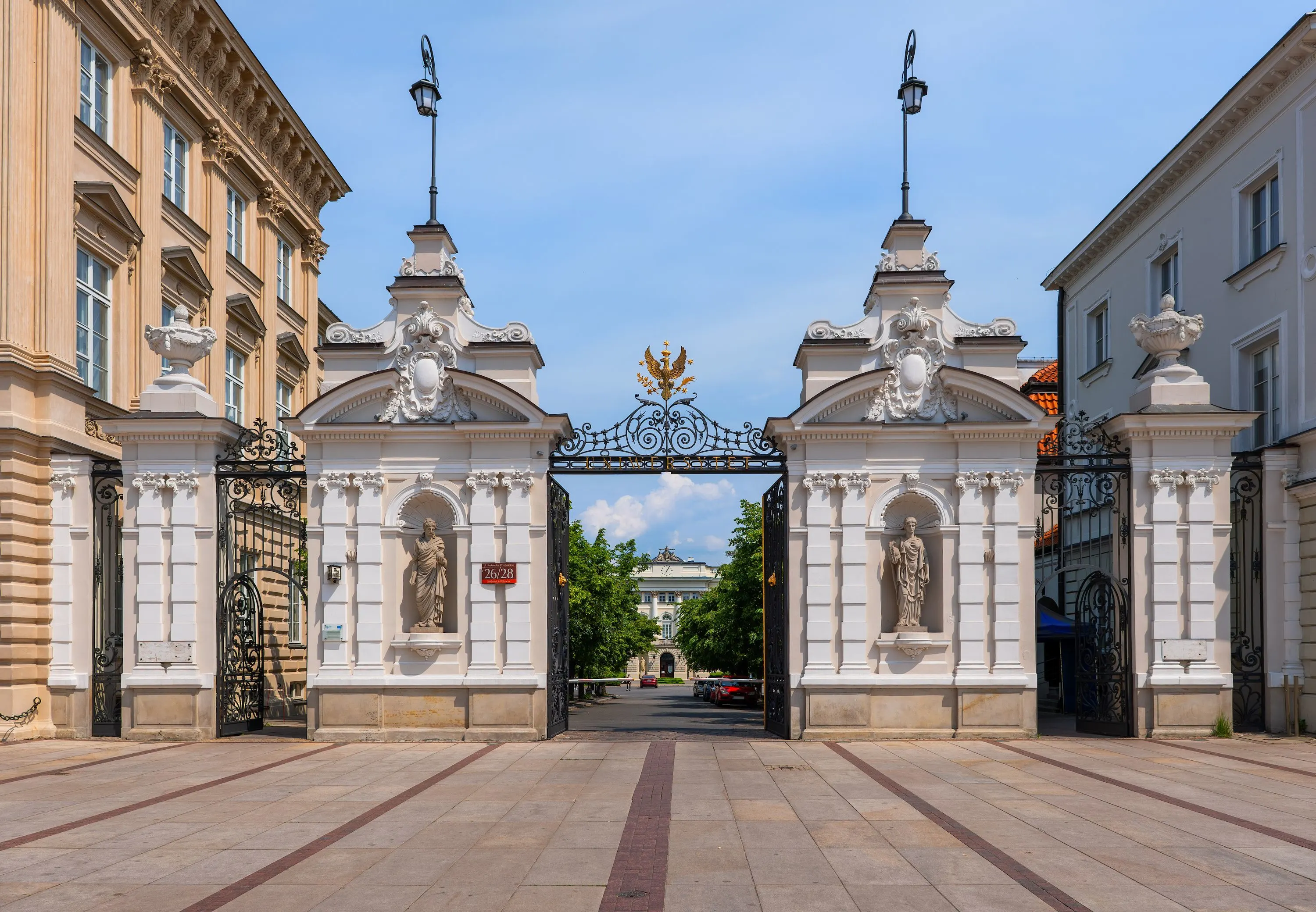
University of Warsaw
 Highlight of Royal Way
Highlight of Royal WayRelax for a little while in the idyllic green campus of the University of Warsaw.
Pass through the University's main gates on the Royal Way, and you can relax within a leafy sanctuary away from the hustle and bustle of the city and discover the 17th-century Kazimierzowski Palace that is now home to the Rector's Office. Unlike many European universities, whose buildings are often scattered throughout hte city in seemingly random fashion, you'll find that this university area very much resembles an American university campus.
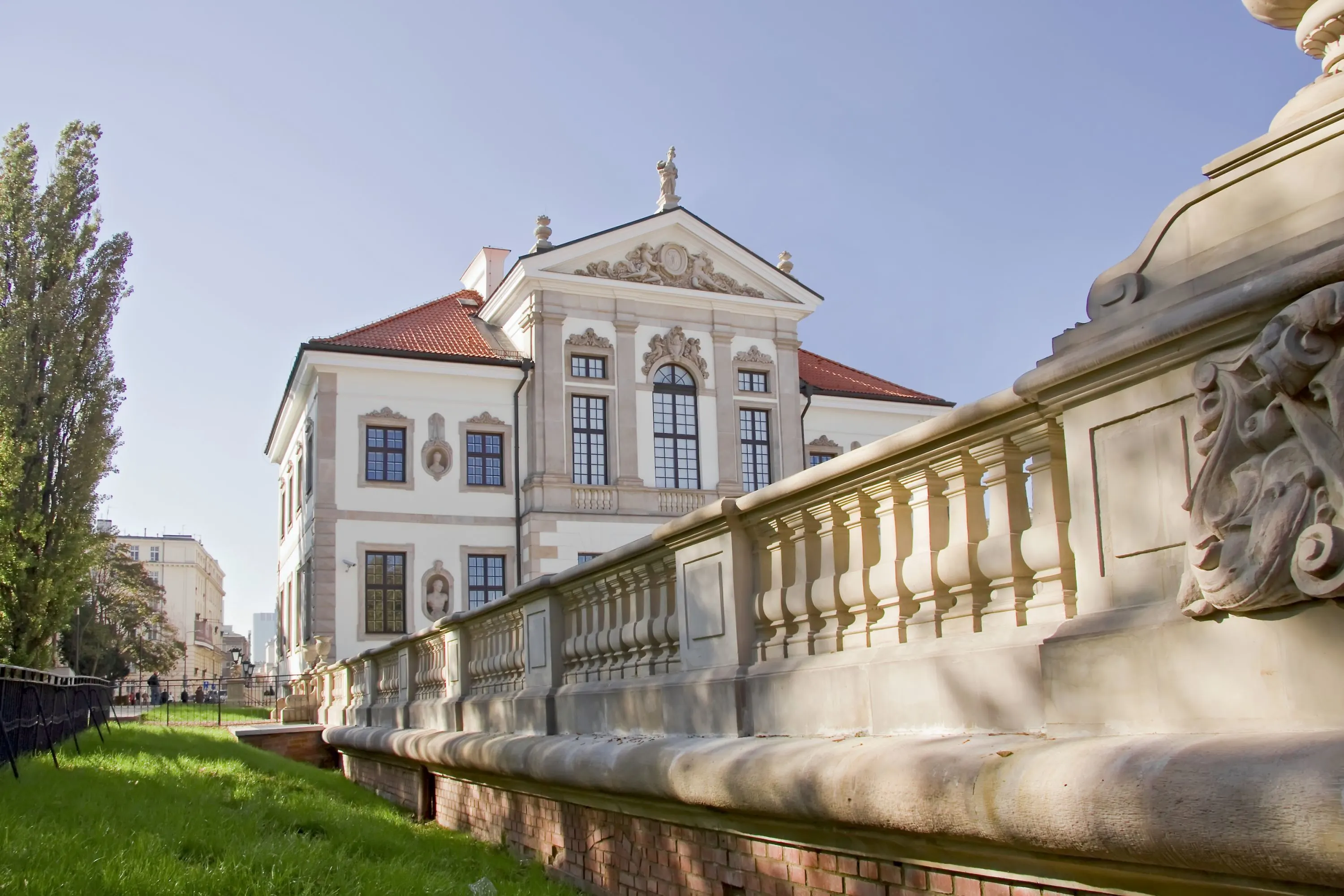
Chopin Museum
 Highlight of Royal Way
Highlight of Royal WayTake an interactive voyage into the life and music of Poland's greatest composer.
Music lovers will not want to miss the Chopin Museum housed in the 17th century Ostrogskich Palace on Okólnik Street. The exhibits cover the life and work of the great Polish composer in significant detail, including many interactive displays. The sound booths in the basement area are particularly good, as you can listen to the music and learn the backstory of each piece. There's also a good souvenir shop in the neighboring building, and if you are lucky, there will even be a live concert or rehearsal in the museum during your visit.
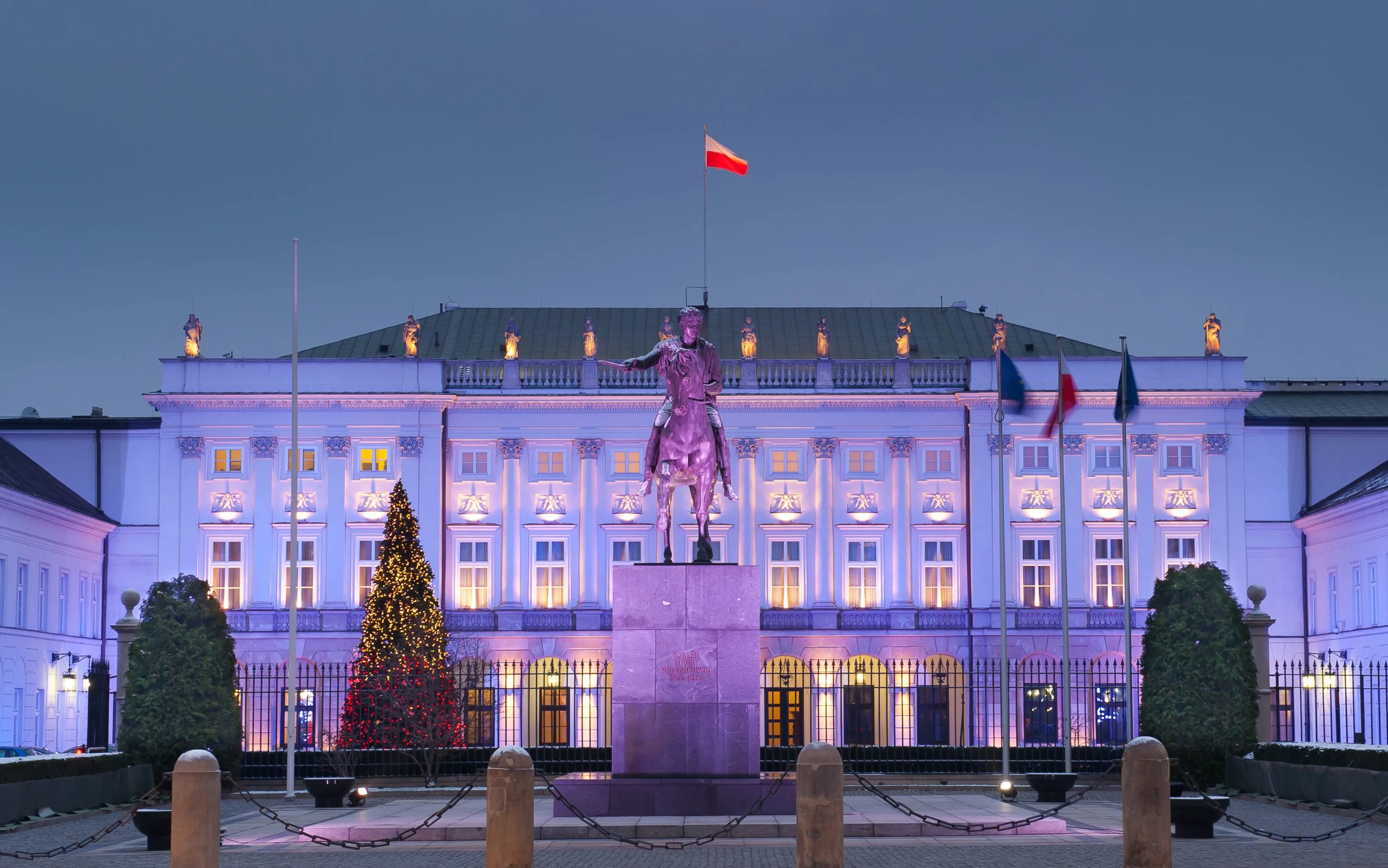
Presidential Palace
 Highlight of Royal Way
Highlight of Royal WayWatch the changing of the guards at Warsaw's Presidential Palace.
Originally built in 1643 as an aristocratic mansion, this palace is now the official residence of the Polish president, but it has a long history of hosting important events. In 1791, it hosted the drafters of Poland's original constitution, which was also Europe's first constitution. It's also where the Warsaw Pact was signed in 1955 and the 'Round Table' talks between the Communist government and the Solidarity-led opposition took place in 1989. In 1995, the Palace gained a new tenant in the person of Lech Wałęsa, signalling its new status as Presidential Palace. You'll see plaques and flowers out front marking the death of President Lech Kaczyński in 2010 in a plane crash in Russian Smolensk. If you stick around you'll be treated to a rather intricate changing of the guard featuring spik and span representatives from all three military services led by officers in their highly distinctive Rogatywka - the asymmetrical, peaked, four-pointed cap used by the Polish military throughout the ages. The changing of the guard takes place on the hour from midday to 5 pm on weekdays, with the most impressive change at midday.

University Library and Roof Garden
 Highlight of Royal Way
Highlight of Royal WayTake a roof-top stroll above the university library to experience a unique garden and great views.
Those interested in modern architecture and/or modern gardening will want to see the very ecologically friendly university library and one of the biggest roof gardens in Europe. The garden is nestled within lunar architecture with beautiful views of the center of Warsaw, the Vistula and of Praga – the district on the other side of the river. The garden is intersected with bridges and pathways that make it a pleasure to explore. Access to the roof is via the lower garden on the left side of the building when facing the river.

Copernicus Science Centre
 Highlight of Royal Way
Highlight of Royal WayKeep the whole family entertained at this innovative and hands-on science museum.
The Copernicus Science Centre and Planetarium are located directly on the banks of the Vistula river. It has great hands-on science exhibits for young and old alike. With over 450 different exhibits, you can carry out experiments and discover the laws of science in a fun and interactive way.

University of Warsaw
 Highlight of Royal Way
Highlight of Royal WayRelax for a little while in the idyllic green campus of the University of Warsaw.
Pass through the University's main gates on the Royal Way, and you can relax within a leafy sanctuary away from the hustle and bustle of the city and discover the 17th-century Kazimierzowski Palace that is now home to the Rector's Office. Unlike many European universities, whose buildings are often scattered throughout hte city in seemingly random fashion, you'll find that this university area very much resembles an American university campus.

Chopin Museum
 Highlight of Royal Way
Highlight of Royal WayTake an interactive voyage into the life and music of Poland's greatest composer.
Music lovers will not want to miss the Chopin Museum housed in the 17th century Ostrogskich Palace on Okólnik Street. The exhibits cover the life and work of the great Polish composer in significant detail, including many interactive displays. The sound booths in the basement area are particularly good, as you can listen to the music and learn the backstory of each piece. There's also a good souvenir shop in the neighboring building, and if you are lucky, there will even be a live concert or rehearsal in the museum during your visit.

Presidential Palace
 Highlight of Royal Way
Highlight of Royal WayWatch the changing of the guards at Warsaw's Presidential Palace.
Originally built in 1643 as an aristocratic mansion, this palace is now the official residence of the Polish president, but it has a long history of hosting important events. In 1791, it hosted the drafters of Poland's original constitution, which was also Europe's first constitution. It's also where the Warsaw Pact was signed in 1955 and the 'Round Table' talks between the Communist government and the Solidarity-led opposition took place in 1989. In 1995, the Palace gained a new tenant in the person of Lech Wałęsa, signalling its new status as Presidential Palace. You'll see plaques and flowers out front marking the death of President Lech Kaczyński in 2010 in a plane crash in Russian Smolensk. If you stick around you'll be treated to a rather intricate changing of the guard featuring spik and span representatives from all three military services led by officers in their highly distinctive Rogatywka - the asymmetrical, peaked, four-pointed cap used by the Polish military throughout the ages. The changing of the guard takes place on the hour from midday to 5 pm on weekdays, with the most impressive change at midday.

University Library and Roof Garden
 Highlight of Royal Way
Highlight of Royal WayTake a roof-top stroll above the university library to experience a unique garden and great views.
Those interested in modern architecture and/or modern gardening will want to see the very ecologically friendly university library and one of the biggest roof gardens in Europe. The garden is nestled within lunar architecture with beautiful views of the center of Warsaw, the Vistula and of Praga – the district on the other side of the river. The garden is intersected with bridges and pathways that make it a pleasure to explore. Access to the roof is via the lower garden on the left side of the building when facing the river.
prev
next

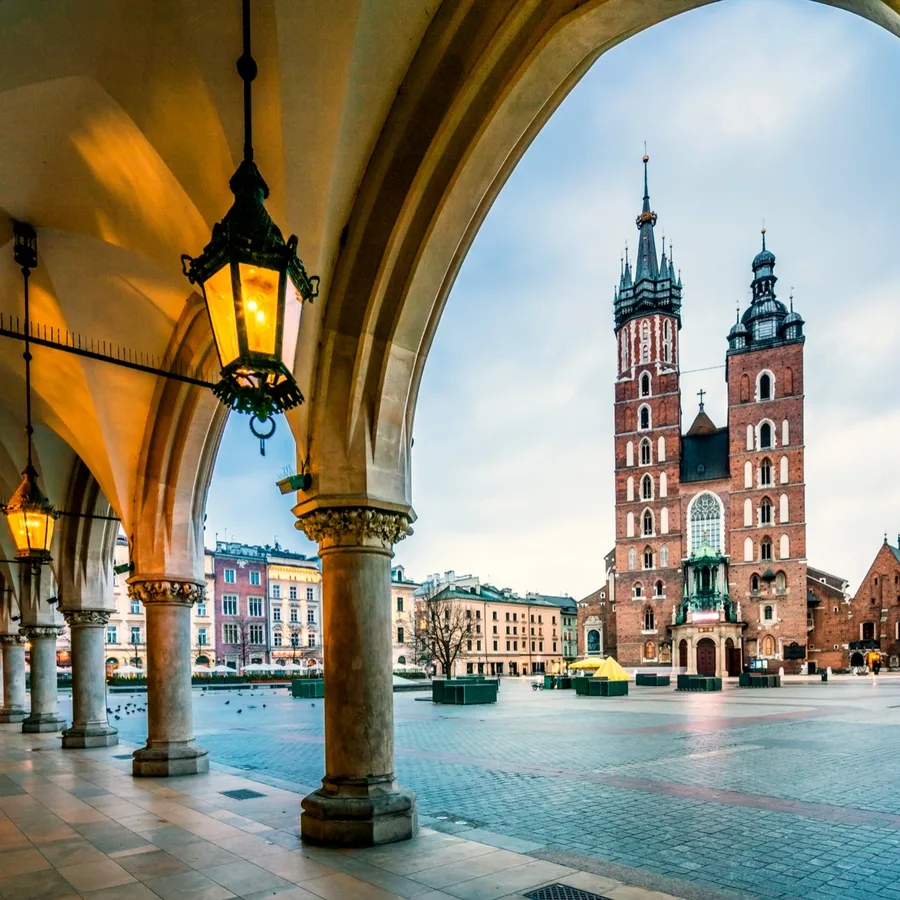
Day 4
Krakow
Day 4
Krakow



9:00 AM - 12:00 PM
Walking Tour of Krakow's Historic Center
On this three-hour guided walking tour, you will discover the history and legends of old Krakow and gain an excellent overview of the city. The many layers of the city will be revealed to you as your guide points out medieval, Renaissance, and Baroque architecture. You will learn about not only Krakow's glory days many centuries past but also about its more recent struggles during Nazism and Communism oppression.

Old Town-Rail Station Tunnel
Show More
Show More


Cloth Hall
Take home something special from a vast market hall built in the 14th century, which is surrounded by arcaded passageways and topped with rows of gargoyles.
Show More

Old Town-Rail Station Tunnel
Show More
Show More


Cloth Hall
Take home something special from a vast market hall built in the 14th century, which is surrounded by arcaded passageways and topped with rows of gargoyles.
Show More

Old Town-Rail Station Tunnel
Show More
Show More


Cloth Hall
Take home something special from a vast market hall built in the 14th century, which is surrounded by arcaded passageways and topped with rows of gargoyles.
Show More
prev
next

Day 4
Krakow

Old Town-Rail Station Tunnel
 Highlight of Krakow Guided Walk
Highlight of Krakow Guided Walk
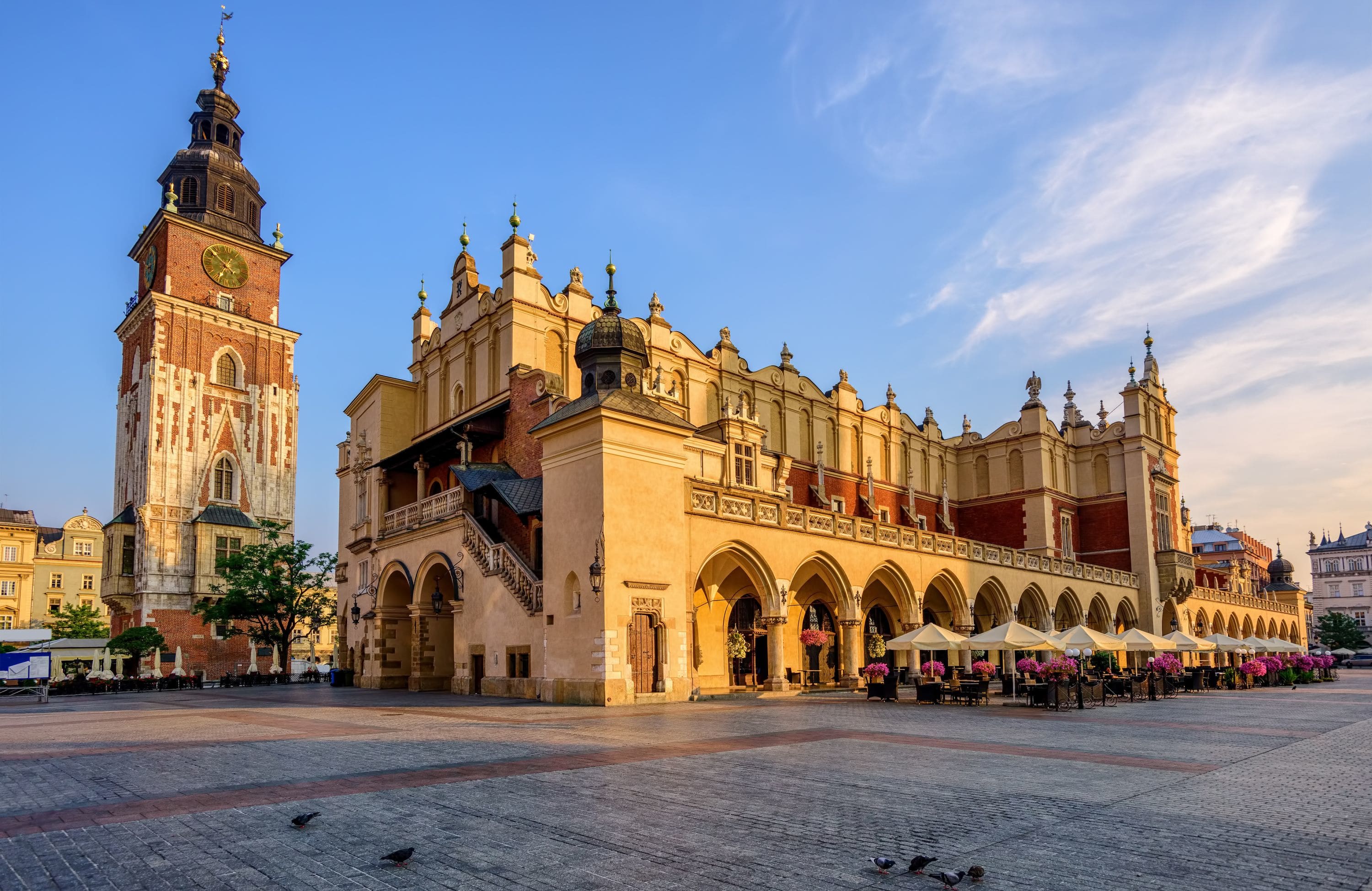
Cloth Hall
 Highlight of Krakow Guided Walk
Highlight of Krakow Guided WalkTake home something special from a vast market hall built in the 14th century, which is surrounded by arcaded passageways and topped with rows of gargoyles.
The covered market continues a centuries-old tradition with an eclectic range of goods of sale – you might be most interested in the amber jewelry or the handicraft items from the Podhale region. On the upper floor, you will find the 19th Century Polish Art Museum which features truly beautiful and under-appreciated artwork that packs a mighty patriotic punch.
Old Town-Rail Station Tunnel
 Highlight of Krakow Guided Walk
Highlight of Krakow Guided Walk

Cloth Hall
 Highlight of Krakow Guided Walk
Highlight of Krakow Guided WalkTake home something special from a vast market hall built in the 14th century, which is surrounded by arcaded passageways and topped with rows of gargoyles.
The covered market continues a centuries-old tradition with an eclectic range of goods of sale – you might be most interested in the amber jewelry or the handicraft items from the Podhale region. On the upper floor, you will find the 19th Century Polish Art Museum which features truly beautiful and under-appreciated artwork that packs a mighty patriotic punch.
Old Town-Rail Station Tunnel
 Highlight of Krakow Guided Walk
Highlight of Krakow Guided Walk

Cloth Hall
 Highlight of Krakow Guided Walk
Highlight of Krakow Guided WalkTake home something special from a vast market hall built in the 14th century, which is surrounded by arcaded passageways and topped with rows of gargoyles.
The covered market continues a centuries-old tradition with an eclectic range of goods of sale – you might be most interested in the amber jewelry or the handicraft items from the Podhale region. On the upper floor, you will find the 19th Century Polish Art Museum which features truly beautiful and under-appreciated artwork that packs a mighty patriotic punch.
prev
next

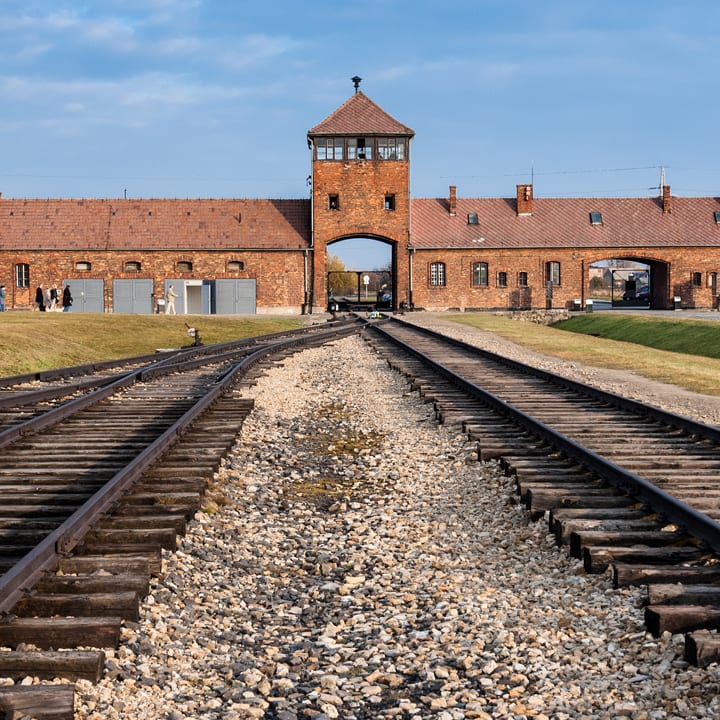
Day 5
Krakow
Day 5
Krakow


8:30 AM - 2:00 PM
Guided Excursion to the Auschwitz Concentration Camp
There is no shortage of cruelty and evil to be found in human history, but the Holocaust stands out as perhaps the greatest of these evils, in both scale and conception. The Holocaust's most significant historical sites, the concentration camp of Auschwitz and its auxiliary camp of Birkenau, are located a little over an hour from Krakow. Important Note About Potential Cancellation Please note that the cost of this tour is non-refundable. If for whatever reason you need to cancel this tour after the tickets have already been purchased we will be unable to return the cost.

Day 5
Krakow


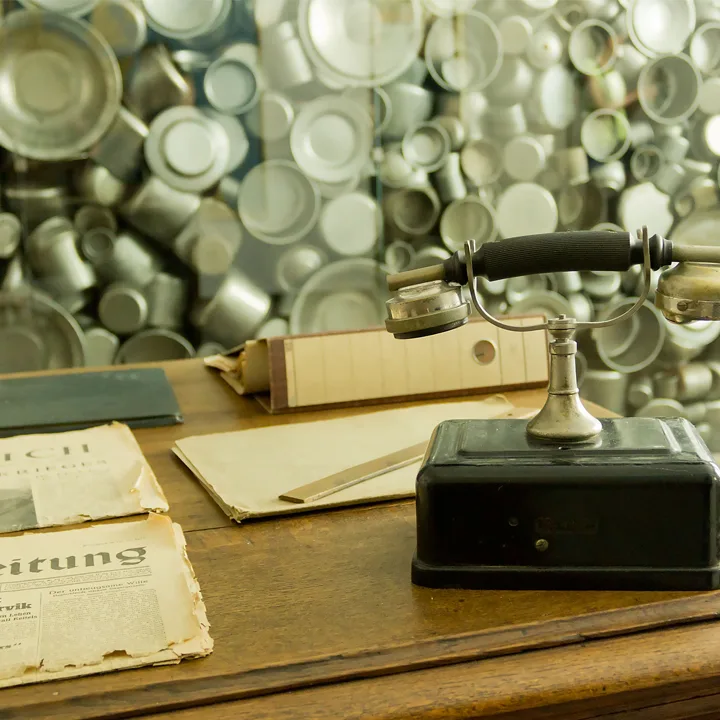
Day 6
Krakow to Prague
Day 6
Krakow to Prague




Morning
Visit to the Schindler's Factory Museum and the Former Ghetto
During World War II Oscar Schindler saved the lives of more than 1,100 Jews by employing them in his enamelware factory in Krakow. Until recently still used as a factory, the building now houses one of Europe's most impressive new museums. It tells not only the story of Schindler and the Jews he protected, but of the wider experience of Krakow during World War II.

Podgórze
Wander the streets of the former Jewish Ghetto.
Show More

Podgórze
Wander the streets of the former Jewish Ghetto.
Show More

Podgórze
Wander the streets of the former Jewish Ghetto.
Show More

Podgórze
Wander the streets of the former Jewish Ghetto.
Show More

Podgórze
Wander the streets of the former Jewish Ghetto.
Show More
prev
next

Day 6
Krakow to Prague

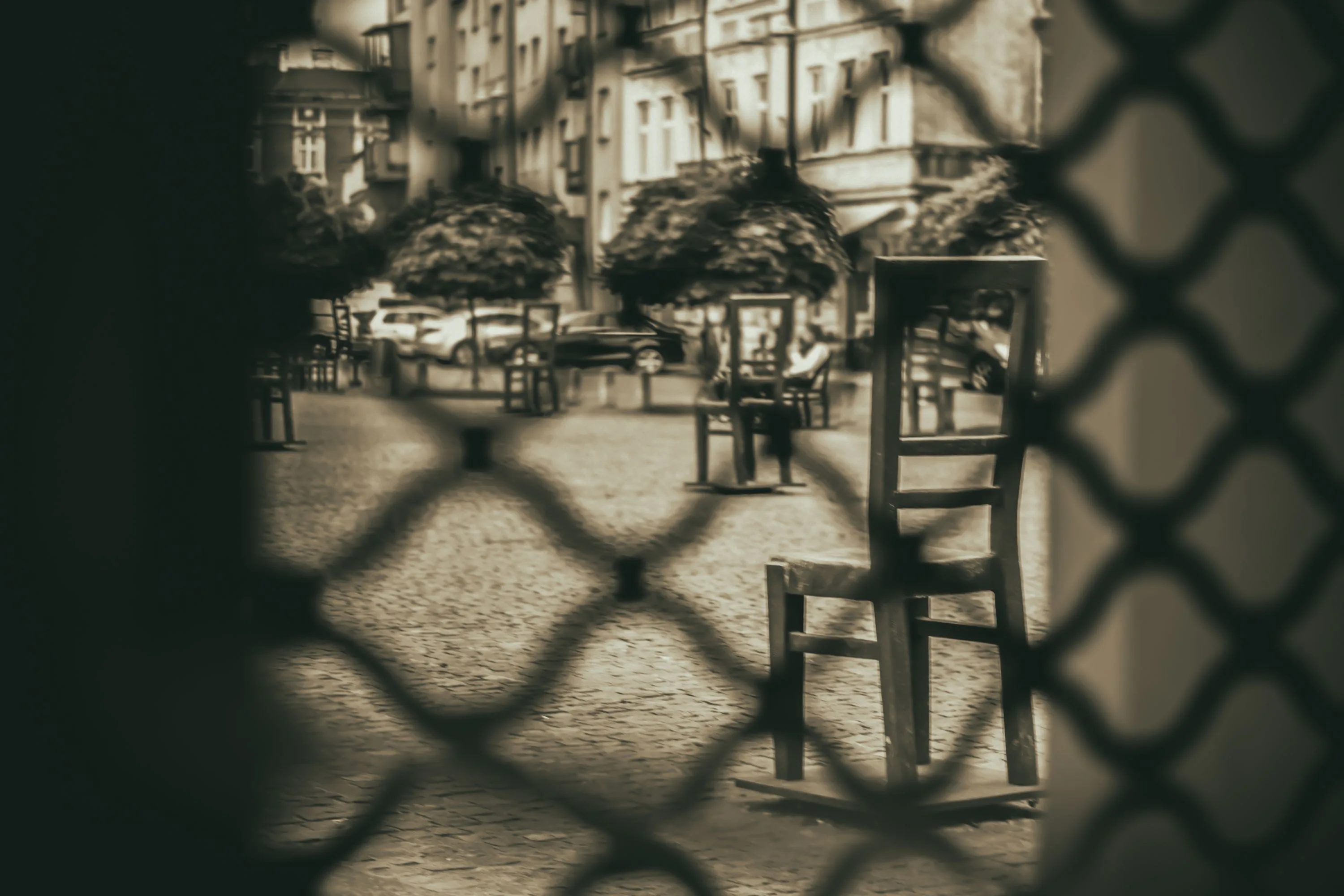
Podgórze
 Highlight of Schindler's Factory Museum
Highlight of Schindler's Factory MuseumWander the streets of the former Jewish Ghetto.
Podgórze is the neighborhood where the Krakow Jewish Ghetto was located. At the beginning of the war, only about 3,000 people lived in the district, but over 15,000 Jews were forcibly moved there and surrounded by tall walls and guarded gates. In 1942-3 the ghetto was "liquidated", with residents sent to either labor camps or extermination camps, or simply murdered in the streets. A couple small sections of the wall and a memorial of empty chairs (each chair representing a 1,000 victims) on the ghetto square are among the very few remaining physical reminders of the ghetto. On the corner of the square, you can also visit the small museum of the Apteka pod Orlem (Pharmacy under the Eagle), which was the only pharmacy allowed to operate in the ghetto. The Polish Catholic owner requested permission to operate within the ghetto and provided medical supplies to residents, often for free. Both he and Oscar Schindler were honored by Israel as "Righteous Among the Nations".

Podgórze
 Highlight of Schindler's Factory Museum
Highlight of Schindler's Factory MuseumWander the streets of the former Jewish Ghetto.
Podgórze is the neighborhood where the Krakow Jewish Ghetto was located. At the beginning of the war, only about 3,000 people lived in the district, but over 15,000 Jews were forcibly moved there and surrounded by tall walls and guarded gates. In 1942-3 the ghetto was "liquidated", with residents sent to either labor camps or extermination camps, or simply murdered in the streets. A couple small sections of the wall and a memorial of empty chairs (each chair representing a 1,000 victims) on the ghetto square are among the very few remaining physical reminders of the ghetto. On the corner of the square, you can also visit the small museum of the Apteka pod Orlem (Pharmacy under the Eagle), which was the only pharmacy allowed to operate in the ghetto. The Polish Catholic owner requested permission to operate within the ghetto and provided medical supplies to residents, often for free. Both he and Oscar Schindler were honored by Israel as "Righteous Among the Nations".

Podgórze
 Highlight of Schindler's Factory Museum
Highlight of Schindler's Factory MuseumWander the streets of the former Jewish Ghetto.
Podgórze is the neighborhood where the Krakow Jewish Ghetto was located. At the beginning of the war, only about 3,000 people lived in the district, but over 15,000 Jews were forcibly moved there and surrounded by tall walls and guarded gates. In 1942-3 the ghetto was "liquidated", with residents sent to either labor camps or extermination camps, or simply murdered in the streets. A couple small sections of the wall and a memorial of empty chairs (each chair representing a 1,000 victims) on the ghetto square are among the very few remaining physical reminders of the ghetto. On the corner of the square, you can also visit the small museum of the Apteka pod Orlem (Pharmacy under the Eagle), which was the only pharmacy allowed to operate in the ghetto. The Polish Catholic owner requested permission to operate within the ghetto and provided medical supplies to residents, often for free. Both he and Oscar Schindler were honored by Israel as "Righteous Among the Nations".

Podgórze
 Highlight of Schindler's Factory Museum
Highlight of Schindler's Factory MuseumWander the streets of the former Jewish Ghetto.
Podgórze is the neighborhood where the Krakow Jewish Ghetto was located. At the beginning of the war, only about 3,000 people lived in the district, but over 15,000 Jews were forcibly moved there and surrounded by tall walls and guarded gates. In 1942-3 the ghetto was "liquidated", with residents sent to either labor camps or extermination camps, or simply murdered in the streets. A couple small sections of the wall and a memorial of empty chairs (each chair representing a 1,000 victims) on the ghetto square are among the very few remaining physical reminders of the ghetto. On the corner of the square, you can also visit the small museum of the Apteka pod Orlem (Pharmacy under the Eagle), which was the only pharmacy allowed to operate in the ghetto. The Polish Catholic owner requested permission to operate within the ghetto and provided medical supplies to residents, often for free. Both he and Oscar Schindler were honored by Israel as "Righteous Among the Nations".

Podgórze
 Highlight of Schindler's Factory Museum
Highlight of Schindler's Factory MuseumWander the streets of the former Jewish Ghetto.
Podgórze is the neighborhood where the Krakow Jewish Ghetto was located. At the beginning of the war, only about 3,000 people lived in the district, but over 15,000 Jews were forcibly moved there and surrounded by tall walls and guarded gates. In 1942-3 the ghetto was "liquidated", with residents sent to either labor camps or extermination camps, or simply murdered in the streets. A couple small sections of the wall and a memorial of empty chairs (each chair representing a 1,000 victims) on the ghetto square are among the very few remaining physical reminders of the ghetto. On the corner of the square, you can also visit the small museum of the Apteka pod Orlem (Pharmacy under the Eagle), which was the only pharmacy allowed to operate in the ghetto. The Polish Catholic owner requested permission to operate within the ghetto and provided medical supplies to residents, often for free. Both he and Oscar Schindler were honored by Israel as "Righteous Among the Nations".
prev
next


Day 7
Prague
Day 7
Prague



9:00 AM - 12:30 PM
Prague Castle & Royal Route Guided Walk
On this charming guided walk, you will explore the Prague Castle, the largest castle complex in all of Europe. To reach the castle you will trace the Royal Coronation Route and cross the Charles Bridge, whose “speaking stones” reveal the amazing and often cruel history that occurred there. Your tour guide will then take you either through the castle courtyards and into the dramatic St. Vitus Cathedral in the center of the castle complex, or through the upper part of the castle district around the oversized palaces of the old Catholic nobility and the top of the Castle Steps for incomparable views over the red rooftops of the Little Quarter.

Charles Bridge
Cross the river dividing Prague's most historic neighborhoods, and experience one of Europe's most iconic landmarks.
Show More

Maltese Square & Lennon Wall
See a historic wall that has been covered in John Lennon-inspired graffiti since Communist days.
Show More

Prague Castle
Prague Castle is one of the main attractions in Prague and is also the largest castle complex in the world.
Show More

Charles Bridge
Cross the river dividing Prague's most historic neighborhoods, and experience one of Europe's most iconic landmarks.
Show More

Maltese Square & Lennon Wall
See a historic wall that has been covered in John Lennon-inspired graffiti since Communist days.
Show More

Prague Castle
Prague Castle is one of the main attractions in Prague and is also the largest castle complex in the world.
Show More

Charles Bridge
Cross the river dividing Prague's most historic neighborhoods, and experience one of Europe's most iconic landmarks.
Show More
prev
next

Day 7
Prague

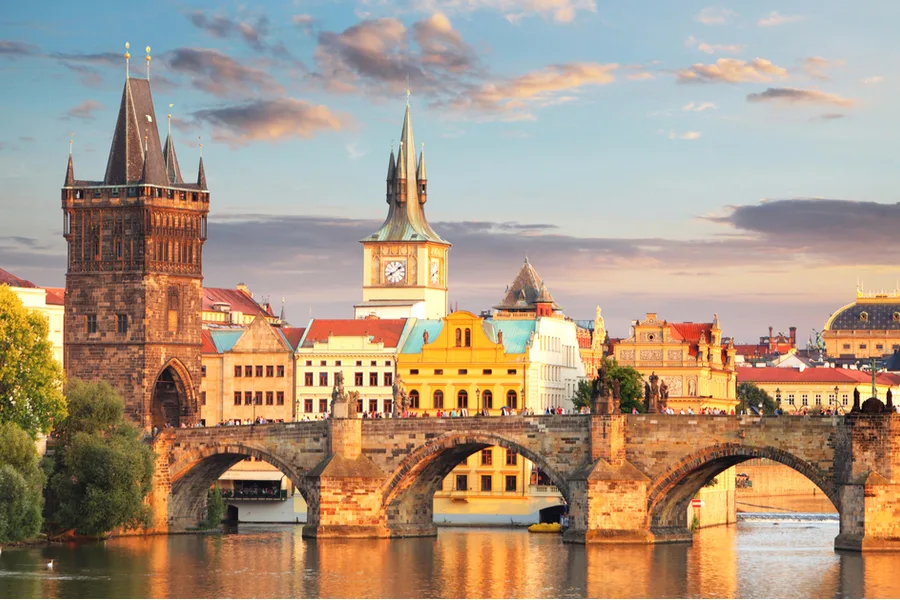
Charles Bridge
 Highlight of Royal Route Guided Tour
Highlight of Royal Route Guided TourCross the river dividing Prague's most historic neighborhoods, and experience one of Europe's most iconic landmarks.
Bridge construction began in 1357 under King Charles IV (hence the name), and it was the only bridge across the Vltava River until 1841. 30 baroque statues of saints line the bridge, and it is filled with street artists and entertainers. Not to be missed.
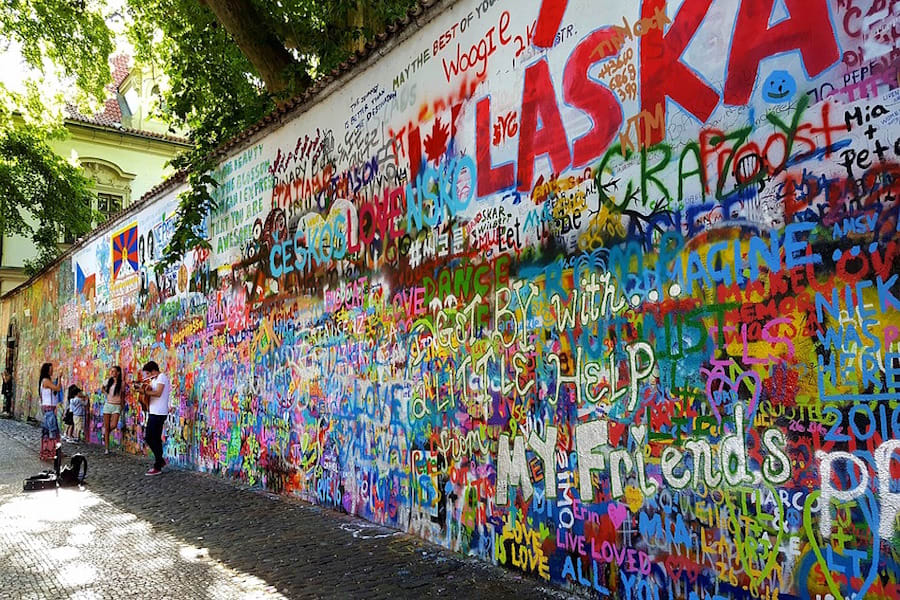
Maltese Square & Lennon Wall
 Highlight of Royal Route Guided Tour
Highlight of Royal Route Guided TourSee a historic wall that has been covered in John Lennon-inspired graffiti since Communist days.
The wall has been covered in graffiti since the 1960s, and during Communism anti-regime sentiment was common. John Lennon's assassination inspired grafitti reflecting his song, Imagine, which earned the wall its current moniker. It is now a favorite gathering place for tourists, and musicians sometimes congregate there as well. Just around the corner is the Maltese Square, which is one of Prague's more quaint and relaxed public spaces, despite being just off the main tourist route.
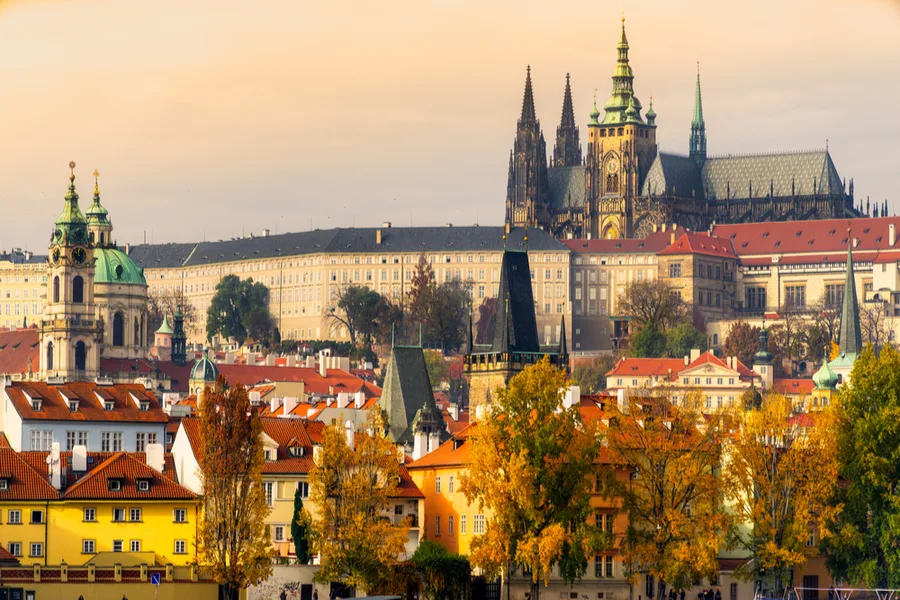
Prague Castle
 Highlight of Royal Route Guided Tour
Highlight of Royal Route Guided TourPrague Castle is one of the main attractions in Prague and is also the largest castle complex in the world.
The Prague Castle is the largest castle complex in the world with structures dating back to the 9th century. The St Vitus Cathedral and Basilica of St George can be found within the castle walls. The Prague Castle also includes several gardens, palaces, and a monastery. This castle was the seat of power for the Kings of Bohemia, Holy Roman Emperors, and presidents of former Czechoslovakia. Prague Castle is a UNESCO world heritage site and is one of the most visited places in the country.

Charles Bridge
 Highlight of Royal Route Guided Tour
Highlight of Royal Route Guided TourCross the river dividing Prague's most historic neighborhoods, and experience one of Europe's most iconic landmarks.
Bridge construction began in 1357 under King Charles IV (hence the name), and it was the only bridge across the Vltava River until 1841. 30 baroque statues of saints line the bridge, and it is filled with street artists and entertainers. Not to be missed.

Maltese Square & Lennon Wall
 Highlight of Royal Route Guided Tour
Highlight of Royal Route Guided TourSee a historic wall that has been covered in John Lennon-inspired graffiti since Communist days.
The wall has been covered in graffiti since the 1960s, and during Communism anti-regime sentiment was common. John Lennon's assassination inspired grafitti reflecting his song, Imagine, which earned the wall its current moniker. It is now a favorite gathering place for tourists, and musicians sometimes congregate there as well. Just around the corner is the Maltese Square, which is one of Prague's more quaint and relaxed public spaces, despite being just off the main tourist route.

Prague Castle
 Highlight of Royal Route Guided Tour
Highlight of Royal Route Guided TourPrague Castle is one of the main attractions in Prague and is also the largest castle complex in the world.
The Prague Castle is the largest castle complex in the world with structures dating back to the 9th century. The St Vitus Cathedral and Basilica of St George can be found within the castle walls. The Prague Castle also includes several gardens, palaces, and a monastery. This castle was the seat of power for the Kings of Bohemia, Holy Roman Emperors, and presidents of former Czechoslovakia. Prague Castle is a UNESCO world heritage site and is one of the most visited places in the country.

Charles Bridge
 Highlight of Royal Route Guided Tour
Highlight of Royal Route Guided TourCross the river dividing Prague's most historic neighborhoods, and experience one of Europe's most iconic landmarks.
Bridge construction began in 1357 under King Charles IV (hence the name), and it was the only bridge across the Vltava River until 1841. 30 baroque statues of saints line the bridge, and it is filled with street artists and entertainers. Not to be missed.
prev
next

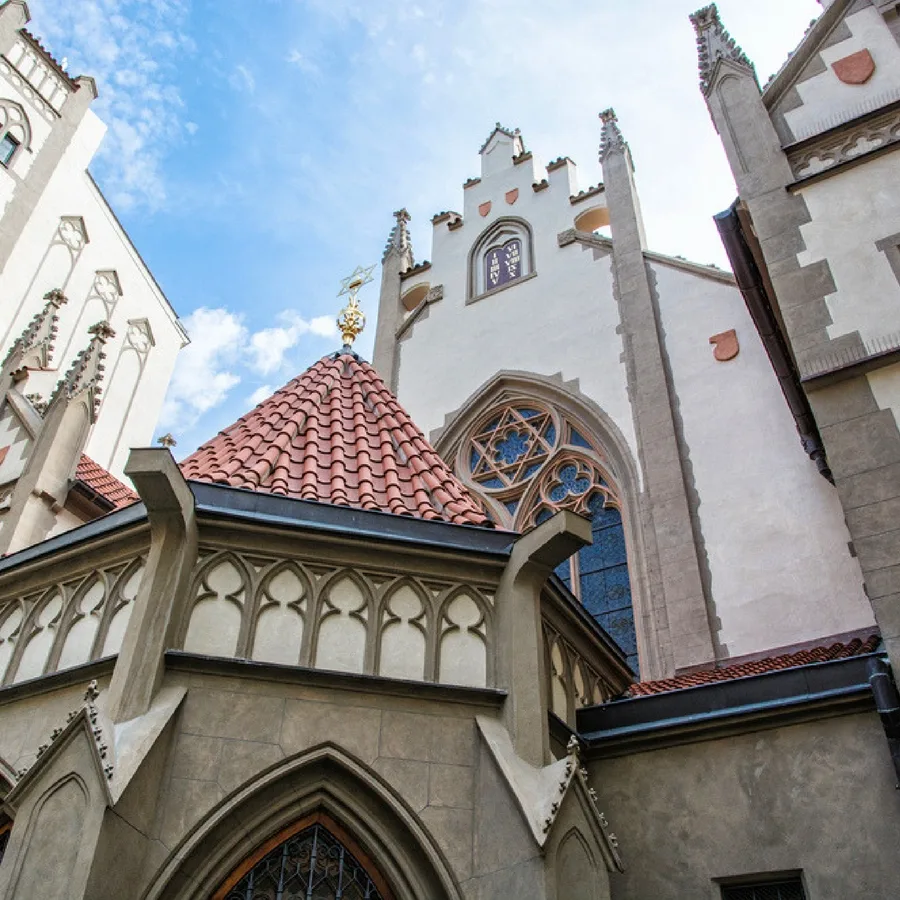
Day 8
Prague
Day 8
Prague



9:00 AM - 12:00 PM
Guided Walk in Prague's Jewish Quarter, including the Cemetery & Synagogues
During this 3 hour guided walk through the former Jewish Ghetto, the tragic fate of Prague's Jewish community will come alive as you learn about the important milestones in its history: the first settlement, the Pogroms, the horror of World War II. You will also experience the rich culture that Prague's Jews created. You will enter the synagogues and walk through the Old Jewish Cemetery, and learn how the Jews of Prague maintained their faith and lived their daily lives amidst a sometimes hostile surrounding population.

Spanish Synagogue
Discover the synagogue considered by many to be Prague's most beautiful.
Show More

Old-New Synagogue
See the oldest surviving synagogue in Europe and also one of Prague's earliest Gothic buildings.
Show More

Old Jewish Cemetery
Take an unforgettable visit to one of Europe's largest medieval Jewish cemeteries.
Show More

Spanish Synagogue
Discover the synagogue considered by many to be Prague's most beautiful.
Show More

Old-New Synagogue
See the oldest surviving synagogue in Europe and also one of Prague's earliest Gothic buildings.
Show More

Old Jewish Cemetery
Take an unforgettable visit to one of Europe's largest medieval Jewish cemeteries.
Show More

Spanish Synagogue
Discover the synagogue considered by many to be Prague's most beautiful.
Show More
prev
next

Day 8
Prague

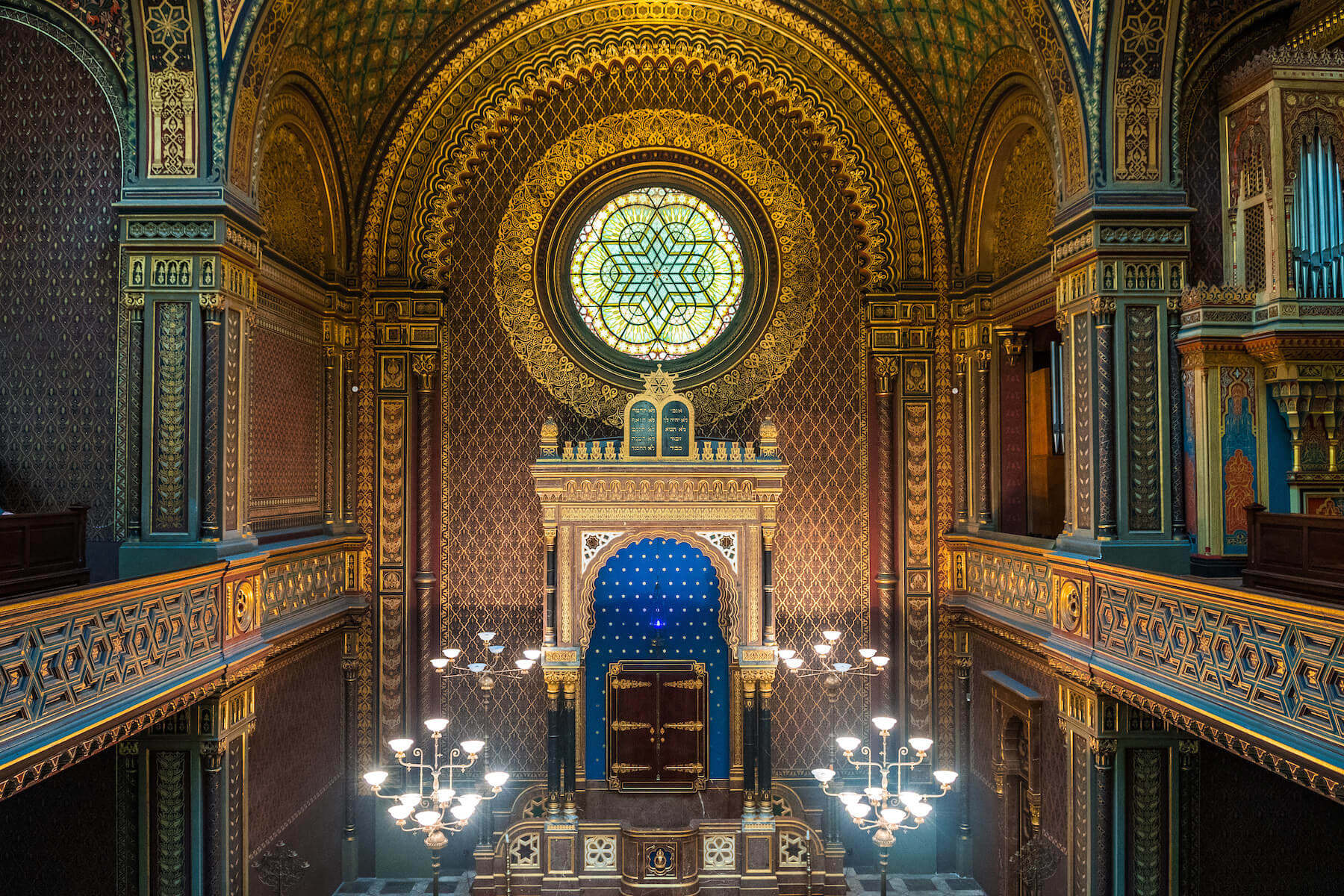
Spanish Synagogue
 Highlight of Guided Jewish Museum Walk
Highlight of Guided Jewish Museum WalkDiscover the synagogue considered by many to be Prague's most beautiful.
Completed in 1868, the Spanish Synagogue is the newest synagogue in Prague's Jewish Quarter, but happens to be built on the site of the former Oldest Synagogue in Prague. It is built in a stunning Spanish Moorish style as a symbol of the flowering of the Jewish culture which occurred under Muslim rule on the Iberian Peninsula.
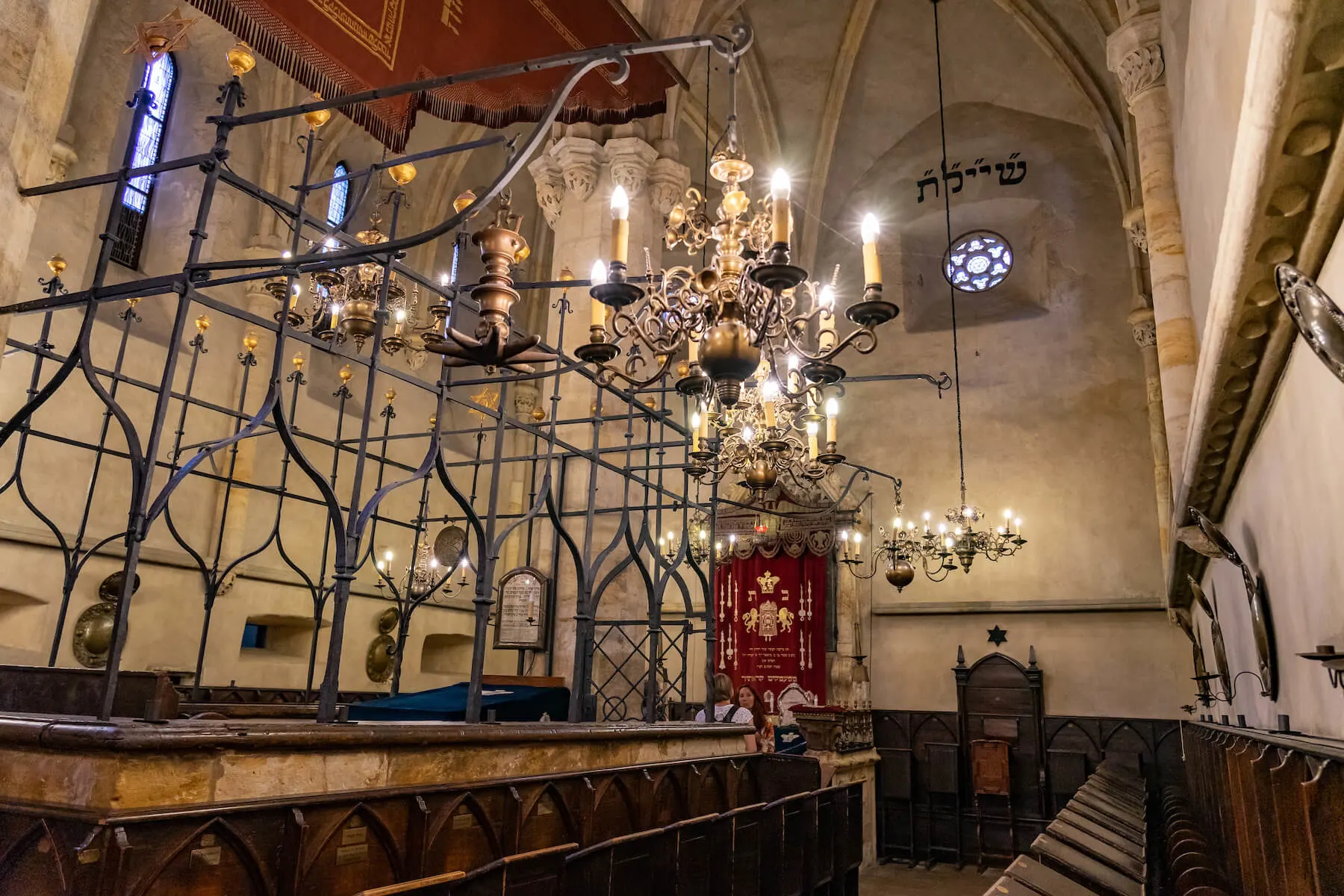
Old-New Synagogue
 Highlight of Guided Jewish Museum Walk
Highlight of Guided Jewish Museum WalkSee the oldest surviving synagogue in Europe and also one of Prague's earliest Gothic buildings.
When built it was Prague’s newest synagogue, but over time became its oldest – hence the “Old-New”. A beautiful ark holds the Torah and legend says its attic is the hiding place of the legendary clay Golem.
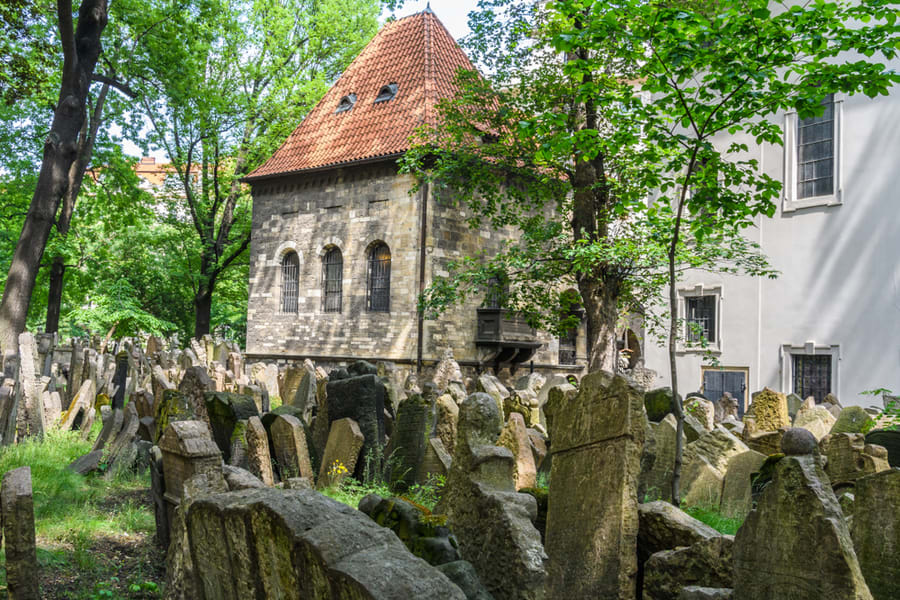
Old Jewish Cemetery
 Highlight of Guided Jewish Museum Walk
Highlight of Guided Jewish Museum WalkTake an unforgettable visit to one of Europe's largest medieval Jewish cemeteries.
As the Jewish Ghetto was quite cramped, there was no room to expand the cemetery. Unable to acquire further land, and not wishing to dishonor ancestors through the demolition of existing graves, Prague's Jews buried their loved ones in multiple levels. Gravestones are packed in tightly and in some areas the burials reach 12 layers!

Spanish Synagogue
 Highlight of Guided Jewish Museum Walk
Highlight of Guided Jewish Museum WalkDiscover the synagogue considered by many to be Prague's most beautiful.
Completed in 1868, the Spanish Synagogue is the newest synagogue in Prague's Jewish Quarter, but happens to be built on the site of the former Oldest Synagogue in Prague. It is built in a stunning Spanish Moorish style as a symbol of the flowering of the Jewish culture which occurred under Muslim rule on the Iberian Peninsula.

Old-New Synagogue
 Highlight of Guided Jewish Museum Walk
Highlight of Guided Jewish Museum WalkSee the oldest surviving synagogue in Europe and also one of Prague's earliest Gothic buildings.
When built it was Prague’s newest synagogue, but over time became its oldest – hence the “Old-New”. A beautiful ark holds the Torah and legend says its attic is the hiding place of the legendary clay Golem.

Old Jewish Cemetery
 Highlight of Guided Jewish Museum Walk
Highlight of Guided Jewish Museum WalkTake an unforgettable visit to one of Europe's largest medieval Jewish cemeteries.
As the Jewish Ghetto was quite cramped, there was no room to expand the cemetery. Unable to acquire further land, and not wishing to dishonor ancestors through the demolition of existing graves, Prague's Jews buried their loved ones in multiple levels. Gravestones are packed in tightly and in some areas the burials reach 12 layers!

Spanish Synagogue
 Highlight of Guided Jewish Museum Walk
Highlight of Guided Jewish Museum WalkDiscover the synagogue considered by many to be Prague's most beautiful.
Completed in 1868, the Spanish Synagogue is the newest synagogue in Prague's Jewish Quarter, but happens to be built on the site of the former Oldest Synagogue in Prague. It is built in a stunning Spanish Moorish style as a symbol of the flowering of the Jewish culture which occurred under Muslim rule on the Iberian Peninsula.
prev
next

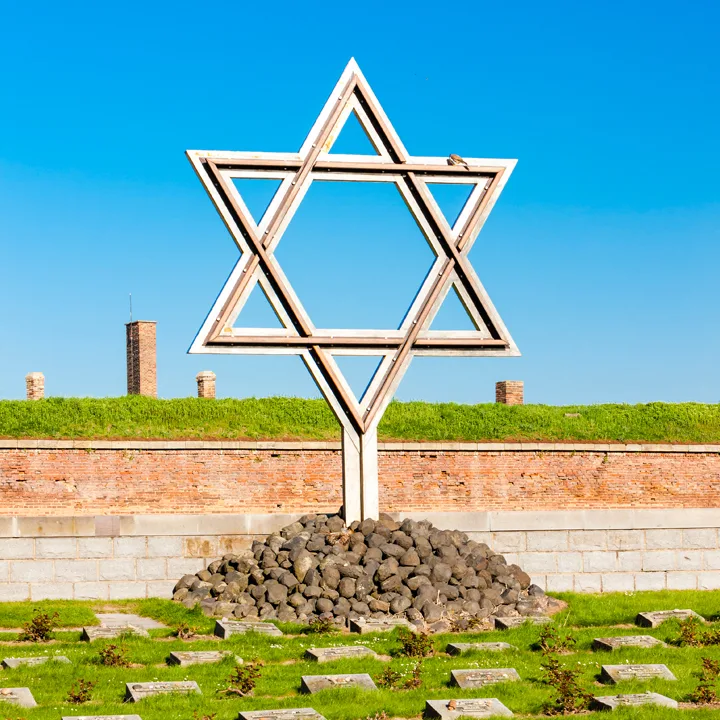
Day 9
Prague
Day 9
Prague


Early Morning to Afternoon
Excursion to the Terezín Concentration Camp
The former Terezín Concentration Camp is where the Nazis created a model “Jewish Town” intended to fool the Red Cross and other observers into thinking that the Jews in Europe were being humanely treated. While the ruse worked, the reality, of course, was that almost all of the Jews located in Terezín were killed, either in Terezín or later in Auschwitz. You can visit the ghetto museum, barracks, and prison, and see exhibitions of music, artworks, literature, and a theater, all created by the prisoners themselves.

Terezín Memorial - The National Cemetery
Respectfully visit a graveyard containing over 2,300 victims of the Holocaust.
Show More

Terezín Memorial - The National Cemetery
Respectfully visit a graveyard containing over 2,300 victims of the Holocaust.
Show More

Terezín Memorial - The National Cemetery
Respectfully visit a graveyard containing over 2,300 victims of the Holocaust.
Show More

Terezín Memorial - The National Cemetery
Respectfully visit a graveyard containing over 2,300 victims of the Holocaust.
Show More

Terezín Memorial - The National Cemetery
Respectfully visit a graveyard containing over 2,300 victims of the Holocaust.
Show More
prev
next

Day 9
Prague


Terezín Memorial - The National Cemetery
 Highlight of Terezín Concentration Camp
Highlight of Terezín Concentration CampRespectfully visit a graveyard containing over 2,300 victims of the Holocaust.
The cemetery was created after the end of the war to hold the remains exhumed from the mass graves. Many were executed or died from disease and exhaustion caused by forced labor and poor conditions. The Nazi response was to simply bury them in mass graves, and survivors wanted a proper cemetery to treat the dead with respect and act as a memorial.

Terezín Memorial - The National Cemetery
 Highlight of Terezín Concentration Camp
Highlight of Terezín Concentration CampRespectfully visit a graveyard containing over 2,300 victims of the Holocaust.
The cemetery was created after the end of the war to hold the remains exhumed from the mass graves. Many were executed or died from disease and exhaustion caused by forced labor and poor conditions. The Nazi response was to simply bury them in mass graves, and survivors wanted a proper cemetery to treat the dead with respect and act as a memorial.

Terezín Memorial - The National Cemetery
 Highlight of Terezín Concentration Camp
Highlight of Terezín Concentration CampRespectfully visit a graveyard containing over 2,300 victims of the Holocaust.
The cemetery was created after the end of the war to hold the remains exhumed from the mass graves. Many were executed or died from disease and exhaustion caused by forced labor and poor conditions. The Nazi response was to simply bury them in mass graves, and survivors wanted a proper cemetery to treat the dead with respect and act as a memorial.

Terezín Memorial - The National Cemetery
 Highlight of Terezín Concentration Camp
Highlight of Terezín Concentration CampRespectfully visit a graveyard containing over 2,300 victims of the Holocaust.
The cemetery was created after the end of the war to hold the remains exhumed from the mass graves. Many were executed or died from disease and exhaustion caused by forced labor and poor conditions. The Nazi response was to simply bury them in mass graves, and survivors wanted a proper cemetery to treat the dead with respect and act as a memorial.

Terezín Memorial - The National Cemetery
 Highlight of Terezín Concentration Camp
Highlight of Terezín Concentration CampRespectfully visit a graveyard containing over 2,300 victims of the Holocaust.
The cemetery was created after the end of the war to hold the remains exhumed from the mass graves. Many were executed or died from disease and exhaustion caused by forced labor and poor conditions. The Nazi response was to simply bury them in mass graves, and survivors wanted a proper cemetery to treat the dead with respect and act as a memorial.
prev
next


Day 10
Prague
Day 10
Prague




Morning
Vyšehrad Fortress; a Favorite of the Locals
The castle of Vyšehrad was the seat of Bohemia's kings from the 11th to the 12th centuries. Due to its strategic position on a hill overlooking the Vltava River and Prague, it became an important army garrison in the 17th century, and it was transformed into a fortress with huge walls, gates, and ramparts. Walking along these ramparts will offer you wonderful views of the city and river. The interior of the fortress is now given over to a pleasant and quiet park which is a favorite of locals.

Vyšehrad Cemetery
Wander in a graveyard where many prominent Czechs are buried, such as famed composers Dvořák & Smětana.
Show More

Fortress Walls Viewpoint
Enjoy stunning city views from atop the fortress walls.
Show More

Brick Gate and Casemates
Venture within the fortress's massive 17th-century walls and gates.
Show More

Vyšehrad Cemetery
Wander in a graveyard where many prominent Czechs are buried, such as famed composers Dvořák & Smětana.
Show More

Fortress Walls Viewpoint
Enjoy stunning city views from atop the fortress walls.
Show More

Brick Gate and Casemates
Venture within the fortress's massive 17th-century walls and gates.
Show More

Vyšehrad Cemetery
Wander in a graveyard where many prominent Czechs are buried, such as famed composers Dvořák & Smětana.
Show More
prev
next

Day 10
Prague

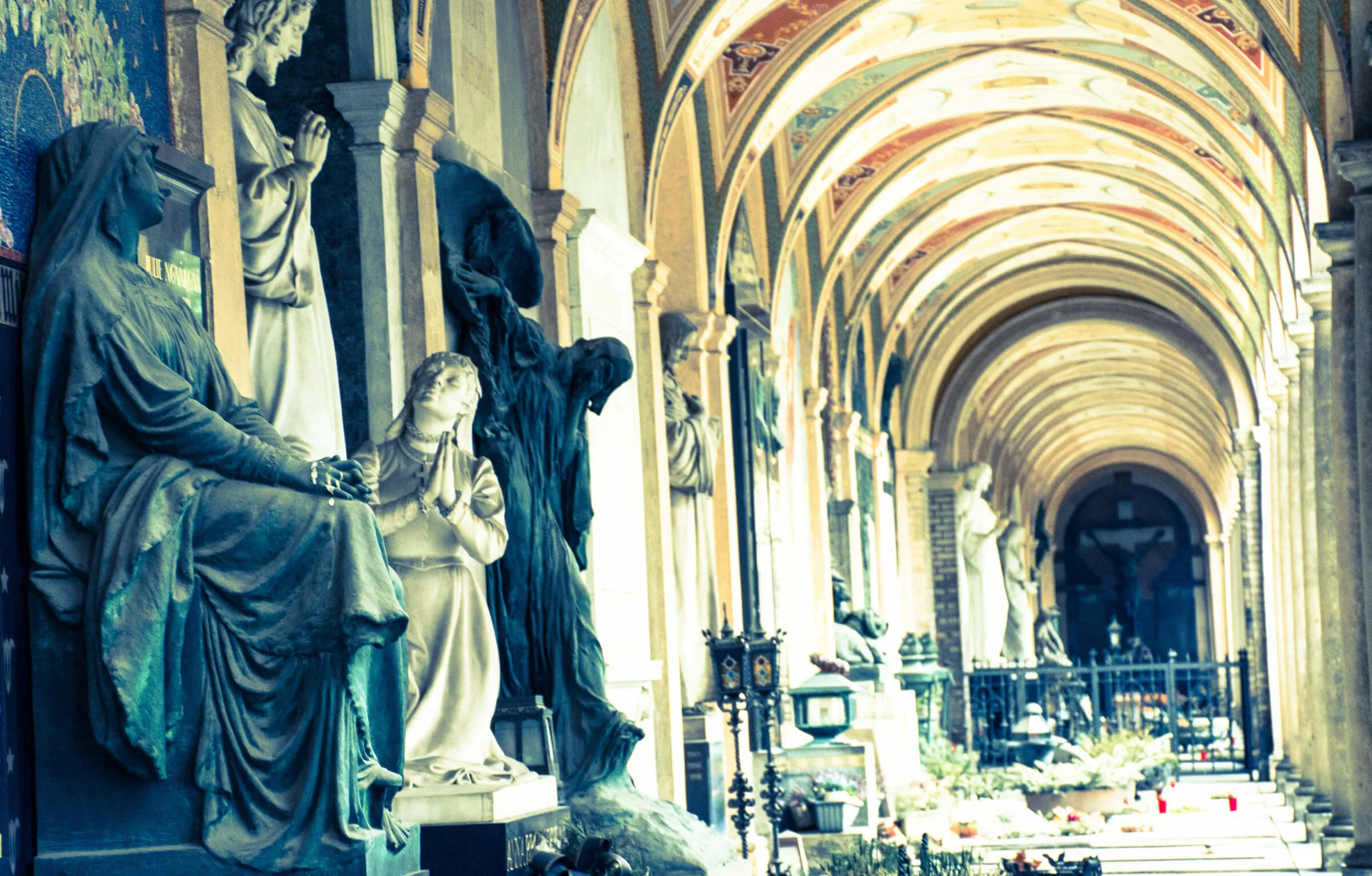
Vyšehrad Cemetery
 Highlight of Vyšehrad Fortress
Highlight of Vyšehrad FortressWander in a graveyard where many prominent Czechs are buried, such as famed composers Dvořák & Smětana.
The cemetery is filled with many tombs which are works of art in themselves, including several arcades with beautiful art-nouveau frescoes. The monumental Slavin tomb is a sort of pantheon of the Czech people, with over 55 prominent persons buried within it. Dvořák and Smětana have their own more modest graves.

Fortress Walls Viewpoint
 Highlight of Vyšehrad Fortress
Highlight of Vyšehrad FortressEnjoy stunning city views from atop the fortress walls.
Prague Castle and most of the city can be seen from above the cavernous Gorlice Hall. A walk along the fortress walls is a delightful experience, as you will enjoy numerous excellent vantage points on all sides of the fortress, enjoying Prague from a different perspective without all the crowds.
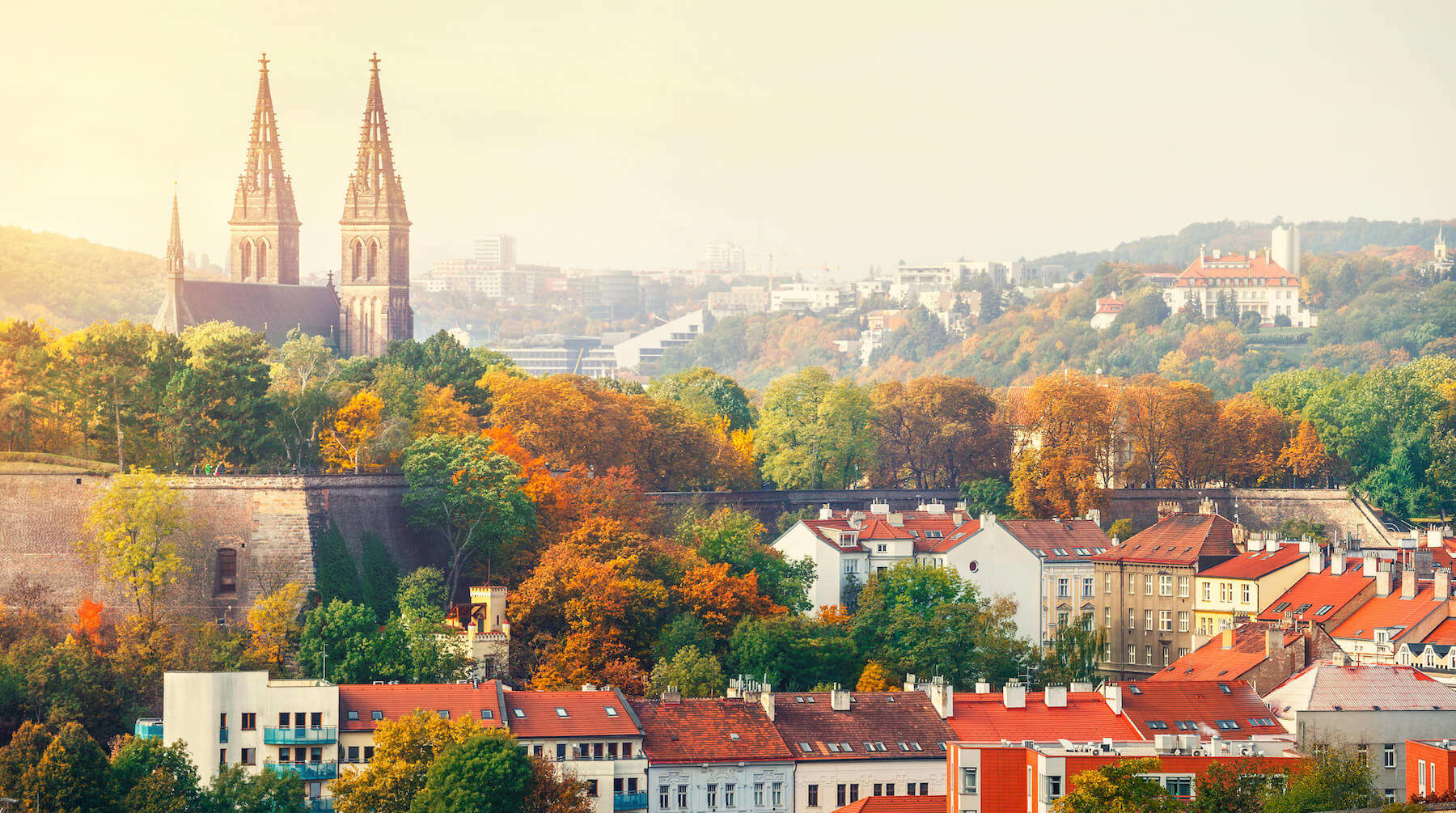
Brick Gate and Casemates
 Highlight of Vyšehrad Fortress
Highlight of Vyšehrad FortressVenture within the fortress's massive 17th-century walls and gates.
A tour through the Brick Gate on the fortress's north side will take you through the narrow underground passageways and casemates of the fortress. You will see a historical exhibit on Vyšehrad as well as the underground Gorlice Hall, where the original statues from the Charles Bridge are stored for safe-keeping (many of the statues on the bridge are copies).

Vyšehrad Cemetery
 Highlight of Vyšehrad Fortress
Highlight of Vyšehrad FortressWander in a graveyard where many prominent Czechs are buried, such as famed composers Dvořák & Smětana.
The cemetery is filled with many tombs which are works of art in themselves, including several arcades with beautiful art-nouveau frescoes. The monumental Slavin tomb is a sort of pantheon of the Czech people, with over 55 prominent persons buried within it. Dvořák and Smětana have their own more modest graves.

Fortress Walls Viewpoint
 Highlight of Vyšehrad Fortress
Highlight of Vyšehrad FortressEnjoy stunning city views from atop the fortress walls.
Prague Castle and most of the city can be seen from above the cavernous Gorlice Hall. A walk along the fortress walls is a delightful experience, as you will enjoy numerous excellent vantage points on all sides of the fortress, enjoying Prague from a different perspective without all the crowds.

Brick Gate and Casemates
 Highlight of Vyšehrad Fortress
Highlight of Vyšehrad FortressVenture within the fortress's massive 17th-century walls and gates.
A tour through the Brick Gate on the fortress's north side will take you through the narrow underground passageways and casemates of the fortress. You will see a historical exhibit on Vyšehrad as well as the underground Gorlice Hall, where the original statues from the Charles Bridge are stored for safe-keeping (many of the statues on the bridge are copies).

Vyšehrad Cemetery
 Highlight of Vyšehrad Fortress
Highlight of Vyšehrad FortressWander in a graveyard where many prominent Czechs are buried, such as famed composers Dvořák & Smětana.
The cemetery is filled with many tombs which are works of art in themselves, including several arcades with beautiful art-nouveau frescoes. The monumental Slavin tomb is a sort of pantheon of the Czech people, with over 55 prominent persons buried within it. Dvořák and Smětana have their own more modest graves.
prev
next

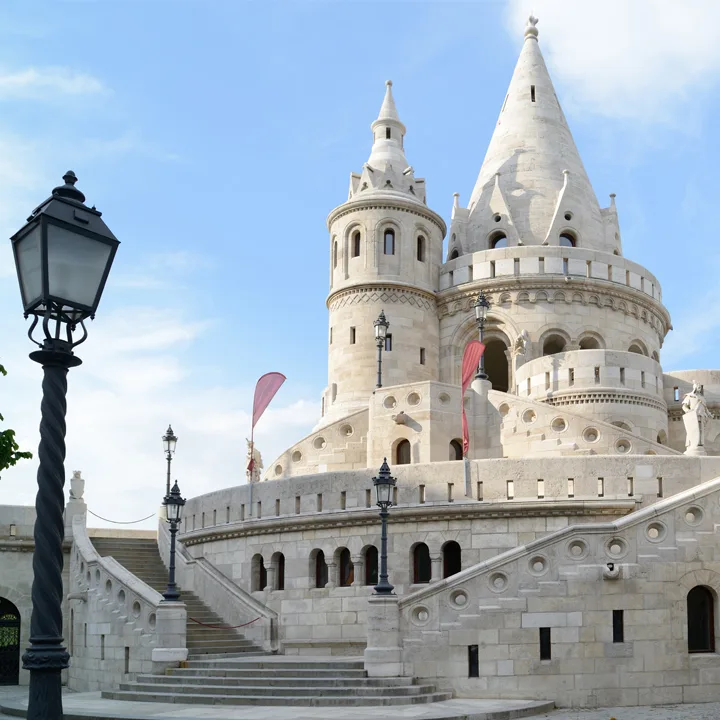
Day 11
Budapest
Day 11
Budapest




8:29 AM
Private Transfer from the Budapest Rail Station
Upon your arrival in Budapest, your driver will meet you on the platform. He will be carrying a sign with your name on it. The driver will drop you off at your hotel. This is a private transfer. The price of the pickup is already included in your itinerary cost so you will not have to pay the driver. IMPORTANT NOTE: Please be aware the car service can fit up to 1 checked item of luggage and 1 personal item per person, such as a purse or small backpack. If you think you will have more baggage, please inform your travel consultant as this may result in an additional fee.

Day 11
Budapest


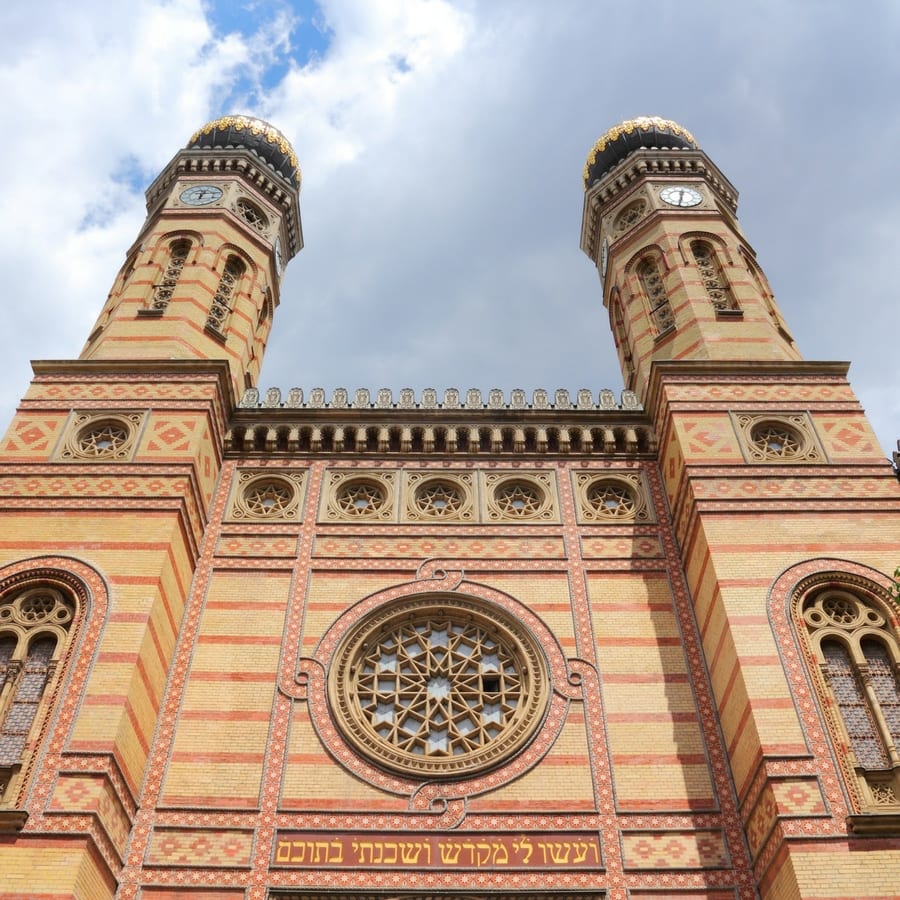
Day 12
Budapest
Day 12
Budapest



9:00 AM - 12:30 PM
Jewish Heritage of Budapest: 1/2 Day Walking Tour
Budapest was once the site of one of Europe's largest and most vibrant Jewish communities and contains the world's second largest synagogue. On this tour, you will explore the contrasting legacies of Jewish achievement and tragedy in Budapest. You will not only visit sites recalling past glories, such as the impressive Great Synagogue, but you will also visit poignant sites such as the riverbank where empty shoes are left as a heartbreaking remembrance of the Jewish families who were machine-gunned into the Danube during World War II.

Holocaust Memorial Center
Learn about the Holocaust in a former synagogue which honors Hungarian Jews killed in WWII.
Show More

Holocaust Memorial Center
Learn about the Holocaust in a former synagogue which honors Hungarian Jews killed in WWII.
Show More

Holocaust Memorial Center
Learn about the Holocaust in a former synagogue which honors Hungarian Jews killed in WWII.
Show More

Holocaust Memorial Center
Learn about the Holocaust in a former synagogue which honors Hungarian Jews killed in WWII.
Show More

Holocaust Memorial Center
Learn about the Holocaust in a former synagogue which honors Hungarian Jews killed in WWII.
Show More
prev
next

Day 12
Budapest


Holocaust Memorial Center
 Highlight of Budapest Jewish Quarter Walking Tour
Highlight of Budapest Jewish Quarter Walking TourLearn about the Holocaust in a former synagogue which honors Hungarian Jews killed in WWII.
The refurbished 1920s synagogue now serves as a museum and memorial for Hungarian Jewish victims of the Holocaust. It also functions as a documentation center. Note, it is actually not located in the Jewish Quarter, which is in Budapest's 7th District, but the nearby 9th District.

Holocaust Memorial Center
 Highlight of Budapest Jewish Quarter Walking Tour
Highlight of Budapest Jewish Quarter Walking TourLearn about the Holocaust in a former synagogue which honors Hungarian Jews killed in WWII.
The refurbished 1920s synagogue now serves as a museum and memorial for Hungarian Jewish victims of the Holocaust. It also functions as a documentation center. Note, it is actually not located in the Jewish Quarter, which is in Budapest's 7th District, but the nearby 9th District.

Holocaust Memorial Center
 Highlight of Budapest Jewish Quarter Walking Tour
Highlight of Budapest Jewish Quarter Walking TourLearn about the Holocaust in a former synagogue which honors Hungarian Jews killed in WWII.
The refurbished 1920s synagogue now serves as a museum and memorial for Hungarian Jewish victims of the Holocaust. It also functions as a documentation center. Note, it is actually not located in the Jewish Quarter, which is in Budapest's 7th District, but the nearby 9th District.

Holocaust Memorial Center
 Highlight of Budapest Jewish Quarter Walking Tour
Highlight of Budapest Jewish Quarter Walking TourLearn about the Holocaust in a former synagogue which honors Hungarian Jews killed in WWII.
The refurbished 1920s synagogue now serves as a museum and memorial for Hungarian Jewish victims of the Holocaust. It also functions as a documentation center. Note, it is actually not located in the Jewish Quarter, which is in Budapest's 7th District, but the nearby 9th District.

Holocaust Memorial Center
 Highlight of Budapest Jewish Quarter Walking Tour
Highlight of Budapest Jewish Quarter Walking TourLearn about the Holocaust in a former synagogue which honors Hungarian Jews killed in WWII.
The refurbished 1920s synagogue now serves as a museum and memorial for Hungarian Jewish victims of the Holocaust. It also functions as a documentation center. Note, it is actually not located in the Jewish Quarter, which is in Budapest's 7th District, but the nearby 9th District.
prev
next

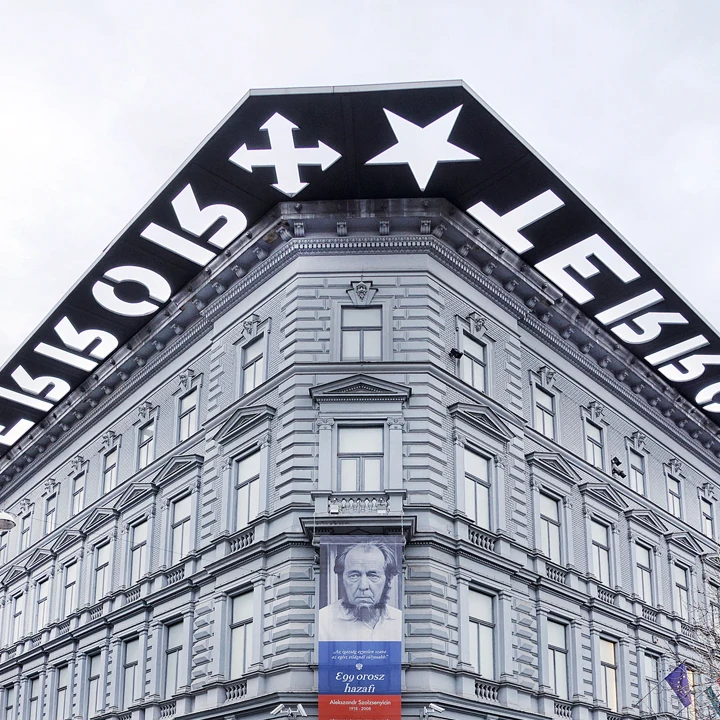
Day 13
Budapest
Day 13
Budapest



9:00 AM - 12:30 PM
Turmoil and Terror: Budapest during World War II and Communism
On this tour, your guide will uncover the history hidden by the passage of time and progress. You will hear the stories of war and repression, and learn how the past still affects the present day reality. You will also discover how people lived their daily lives under Communist rule from a first-hand perspective. The tour concludes with a visit to the superb Terror Museum.

House of Terror Museum
Experience a chilling museum documenting the terrors of Fascism & Communism in Hungary .
Show More

House of Terror Museum
Experience a chilling museum documenting the terrors of Fascism & Communism in Hungary .
Show More

House of Terror Museum
Experience a chilling museum documenting the terrors of Fascism & Communism in Hungary .
Show More

House of Terror Museum
Experience a chilling museum documenting the terrors of Fascism & Communism in Hungary .
Show More

House of Terror Museum
Experience a chilling museum documenting the terrors of Fascism & Communism in Hungary .
Show More
prev
next

Day 13
Budapest


House of Terror Museum
 Highlight of Guided WWII Terror Walking Tour
Highlight of Guided WWII Terror Walking TourExperience a chilling museum documenting the terrors of Fascism & Communism in Hungary .
This somber and foreboding interactive museum tells the tragic story of Hungary's totalitarian experiences under Fascism and Communism. It is located in the headquarters building of the Arrow Cross Party (Hungarian fascists), and later the Communist secret police after WWII. Hear stories of those who suffered as well as their oppressors, and wander the dank cells where victims were tortured and interrogated.

House of Terror Museum
 Highlight of Guided WWII Terror Walking Tour
Highlight of Guided WWII Terror Walking TourExperience a chilling museum documenting the terrors of Fascism & Communism in Hungary .
This somber and foreboding interactive museum tells the tragic story of Hungary's totalitarian experiences under Fascism and Communism. It is located in the headquarters building of the Arrow Cross Party (Hungarian fascists), and later the Communist secret police after WWII. Hear stories of those who suffered as well as their oppressors, and wander the dank cells where victims were tortured and interrogated.

House of Terror Museum
 Highlight of Guided WWII Terror Walking Tour
Highlight of Guided WWII Terror Walking TourExperience a chilling museum documenting the terrors of Fascism & Communism in Hungary .
This somber and foreboding interactive museum tells the tragic story of Hungary's totalitarian experiences under Fascism and Communism. It is located in the headquarters building of the Arrow Cross Party (Hungarian fascists), and later the Communist secret police after WWII. Hear stories of those who suffered as well as their oppressors, and wander the dank cells where victims were tortured and interrogated.

House of Terror Museum
 Highlight of Guided WWII Terror Walking Tour
Highlight of Guided WWII Terror Walking TourExperience a chilling museum documenting the terrors of Fascism & Communism in Hungary .
This somber and foreboding interactive museum tells the tragic story of Hungary's totalitarian experiences under Fascism and Communism. It is located in the headquarters building of the Arrow Cross Party (Hungarian fascists), and later the Communist secret police after WWII. Hear stories of those who suffered as well as their oppressors, and wander the dank cells where victims were tortured and interrogated.

House of Terror Museum
 Highlight of Guided WWII Terror Walking Tour
Highlight of Guided WWII Terror Walking TourExperience a chilling museum documenting the terrors of Fascism & Communism in Hungary .
This somber and foreboding interactive museum tells the tragic story of Hungary's totalitarian experiences under Fascism and Communism. It is located in the headquarters building of the Arrow Cross Party (Hungarian fascists), and later the Communist secret police after WWII. Hear stories of those who suffered as well as their oppressors, and wander the dank cells where victims were tortured and interrogated.
prev
next


Day 14
Depart Budapest
Day 14
Depart Budapest

To Be Determined
Transfer to Airport by Taxi
Budapest has one main airport, Budapest Ferenc Liszt International Airport, where almost all visitors depart. Your hotel can arrange a reliable taxi (there is no Uber in Budapest). You can also arrange a private transfer. If you are picked up about two hours and forty-five minutes before your departure time, you should arrive at the airport with about two hours to spare, depending on traffic. If you are leaving during rush hour, you may want to budget an extra fifteen to thirty minutes.

Day 14
Depart Budapest


What's Included In Your Trip

Pre-Paid Tours and Activities:
- Walking Tour of Krakow's Historic Center
- Guided Excursion to the Auschwitz Concentration Camp
- Prague Castle & Royal Route Guided Walk
- Guided Walk in Prague's Jewish Quarter, including the Cemetery & Synagogues
- Jewish Heritage of Budapest: 1/2 Day Walking Tour
- Turmoil and Terror: Budapest during World War II and Communism
- City Card for Krakow, including discounts to many popular attractions

Pre-Paid Transportation:
- 2nd Class Train Tickets from Warsaw to Krakow
- Train Tickets from Krakow to Prague
- Train Tickets from Prague to Budapest
- Public Transport Tickets for Krakow
- Private Transfer from Krakow Rail Station to Your Hotel
- Private Transfer from the Budapest Rail Station

Accommodation:
- 3 nights at a hotel of your choice in Warsaw
- 4 nights at a hotel of your choice in Krakow
- 5 nights at a hotel of your choice in Prague
- 4 nights at a hotel of your choice in Budapest

Go Real Travel Mobile App:
- Itinerary Plan & Reservations Info
- Points of Interest
- Detailed Travel Information
- Maps & Directions
Other Trips You May Like

7 Days
From$1489USD

15 Days
From$2750USD
Prague, Vienna, and Budapest, 15 Days of Must See Sights & Local Scenes

Czech Republic, Austria, Hungary

8 Days
From$1425USD
Enchanting Central Europe: 8-Days in Prague, Vienna & Budapest

Czech Republic, Austria, Hungary

12 Days
From$2675USD
Jewish Heritage and Scenic Rivers: A Journey through Prague, Vienna, and Budapest

Hungary, Austria, Czech Republic

15 Days
From$2575USD
Highlights of Budapest, Vienna, Prague, Krakow & Warsaw in 15 days

Hungary, Austria, Czech Republic, Poland

12 Days
From$2350USD

14 Days
From$2875USD
2-Week Journey Through Central & Eastern Europe: History

Germany, Czech Republic, Austria, Hungary, Poland

7 Days
From$1265USD

14 Days
From$2350USD
Imperial Elegance: Prague, Vienna and Budapest Itinerary 14 Days

Czech Republic, Austria, Hungary

7 Days
From$1489USD

15 Days
From$2750USD
Prague, Vienna, and Budapest, 15 Days of Must See Sights & Local Scenes

Czech Republic, Austria, Hungary

8 Days
From$1425USD
Enchanting Central Europe: 8-Days in Prague, Vienna & Budapest

Czech Republic, Austria, Hungary

12 Days
From$2675USD
Jewish Heritage and Scenic Rivers: A Journey through Prague, Vienna, and Budapest

Hungary, Austria, Czech Republic

15 Days
From$2575USD
Highlights of Budapest, Vienna, Prague, Krakow & Warsaw in 15 days

Hungary, Austria, Czech Republic, Poland

12 Days
From$2350USD

14 Days
From$2875USD
2-Week Journey Through Central & Eastern Europe: History

Germany, Czech Republic, Austria, Hungary, Poland

7 Days
From$1265USD

14 Days
From$2350USD
Imperial Elegance: Prague, Vienna and Budapest Itinerary 14 Days

Czech Republic, Austria, Hungary
prev
next
Featured Blogs
prev
next
Our Customers Say It Best
Marianne Strydom, Paarl, South Africa
I just wanted to thank you for organizing an amazing trip for me – I packed in so much in such a short period of time and everything was just perfect. The way you do things makes it possible to really get to know the destination, which for me as a travel agent could not have been better. 

Otto Chuy, Los Angeles, California
I am still surprised how everything worked as planned, without a hitch. All instructions in your itinerary were precise and correct. Your suggestions and comments in each of the locations we went to were very helpful. All your guides, without exception, were wonderful and exactly on time. 

Malini Dutta, Boston, Massachusetts
We can't thank you enough for the detailed plans, maps, and suggestions. It really felt that someone was holding our hands and showing us around. We had all the excitement of discovering foreign lands, with none of the problems that can happen while negotiating unfamiliar places. In fact, all the cities felt like home within a few hours of arriving and exploring. 

Bev and Mark Frankel, Williamsburg, Virginia
We could not be more pleased with Go Real Travel! You took the guess work out of things like public transport but still managed to allow us the freedom to tour as we wanted. Our guides were exceptional and every time I saw a Viking Cruise tour of 25 people, I realized the quality experience we were getting with Go Real. 

Marianne Strydom, Paarl, South Africa
I just wanted to thank you for organizing an amazing trip for me – I packed in so much in such a short period of time and everything was just perfect. The way you do things makes it possible to really get to know the destination, which for me as a travel agent could not have been better. 

Otto Chuy, Los Angeles, California
I am still surprised how everything worked as planned, without a hitch. All instructions in your itinerary were precise and correct. Your suggestions and comments in each of the locations we went to were very helpful. All your guides, without exception, were wonderful and exactly on time. 

Malini Dutta, Boston, Massachusetts
We can't thank you enough for the detailed plans, maps, and suggestions. It really felt that someone was holding our hands and showing us around. We had all the excitement of discovering foreign lands, with none of the problems that can happen while negotiating unfamiliar places. In fact, all the cities felt like home within a few hours of arriving and exploring. 

Bev and Mark Frankel, Williamsburg, Virginia
We could not be more pleased with Go Real Travel! You took the guess work out of things like public transport but still managed to allow us the freedom to tour as we wanted. Our guides were exceptional and every time I saw a Viking Cruise tour of 25 people, I realized the quality experience we were getting with Go Real. 



Explore cities in more detail
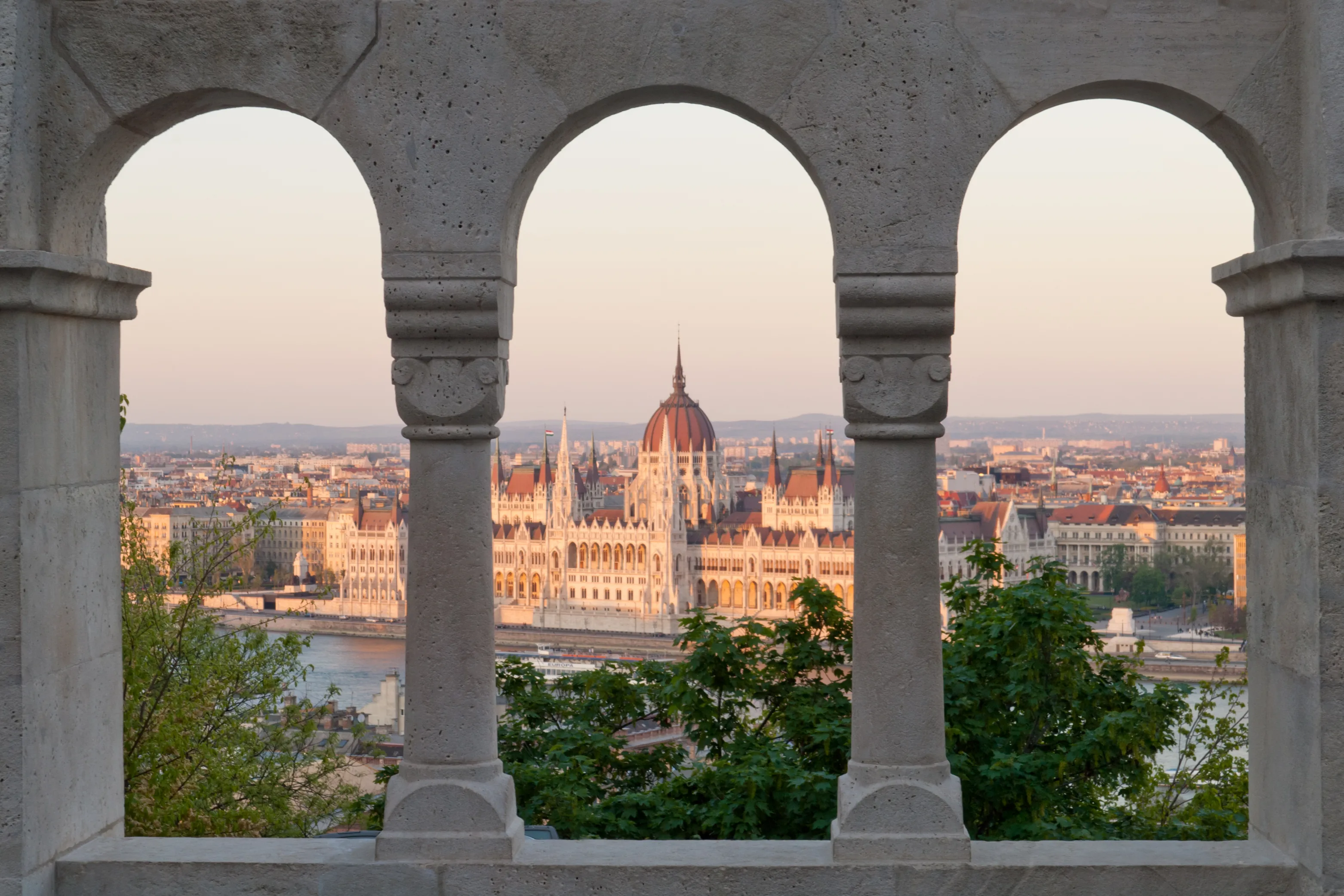
Budapest
Situated at the heart of Europe, Budapest is the capital of Hungary, appropriately named 'The Pearl of the Danube,' for its fixating and almost haunting beauty. Formerly two separate cities, Buda and Pest were forged into one by time, occupation, and the eight bridges that anchor them together today. From the Romans to the Communists, each occupier left its flavor profile in Budapest, evident in the famous spicy Hungarian stew known as 'goulash.' Budapest is a melting pot of history, culture, and taste, from the magnificent Baroque and neo-Gothic architecture to the Turkish thermal baths. After a long day of sightseeing, treat yourself to a glass of Tokaj, what King Louis XIV of France referred to as the "Wine of Kings, King of Wines". Budapest has a flavor to satisfy any taste.

Learn About Budapest
Build Budapest Trip
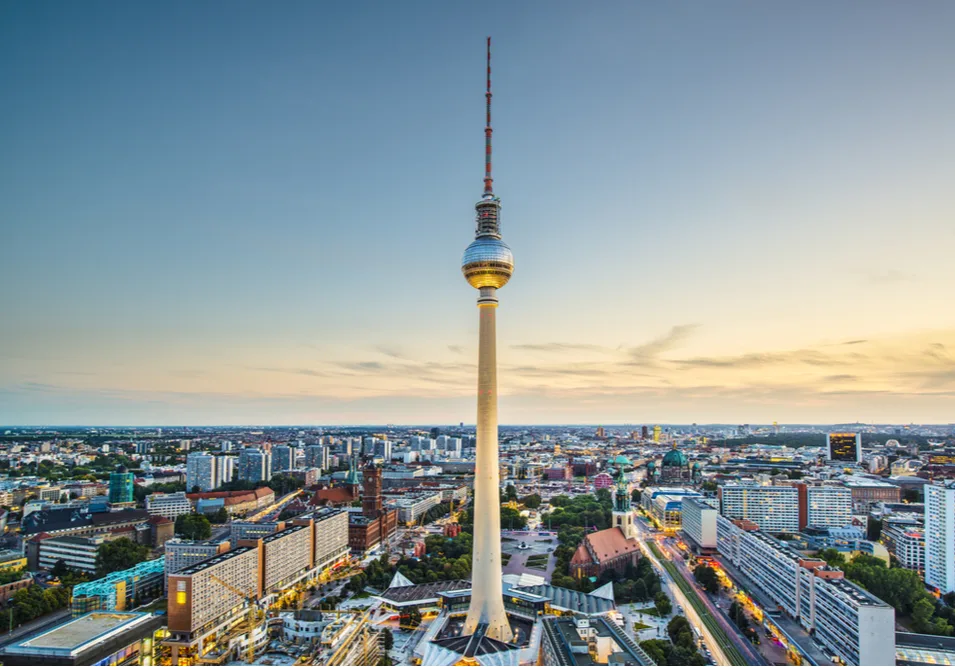
Berlin
Since the fall of its notorious wall, Berlin’s unification has seen it go from strength to strength. No wonder the city feels like it hasn’t stopped partying since the 1990s. There is so much to celebrate here. Fueled by the robust economy, a thriving tech scene, and straight-up German bonhomie, when you step into Berlin you’ll soon be caught up in its spirit. For all this gusto, Berlin hasn’t forgotten its troubled past. A visit to Berlin is to bear witness to history. Portions of the wall remain intact, and the city’s Jewish Museum offers a detailed, emotional examination of the Holocaust. Inside the reconstructed Reichstag, every attempt has been made to preserve the parliament’s beleaguered history. The buildings' glass dome addition feels less like a triumphal crown and more like a freshly healed battle scar. Days in Berlin are easily spent wandering from a cafe to the cultural institutions on Museum Island, or over to the Charlottenburg Palace. By night, crowds wander through the booming bars and nightclubs or gaze upon the floodlit Brandenburg Gate and Victory Column monuments. An international city that can offer something to everyone, Berlin is an unmissable stop on your German journey.

Learn About Berlin
Build Berlin Trip
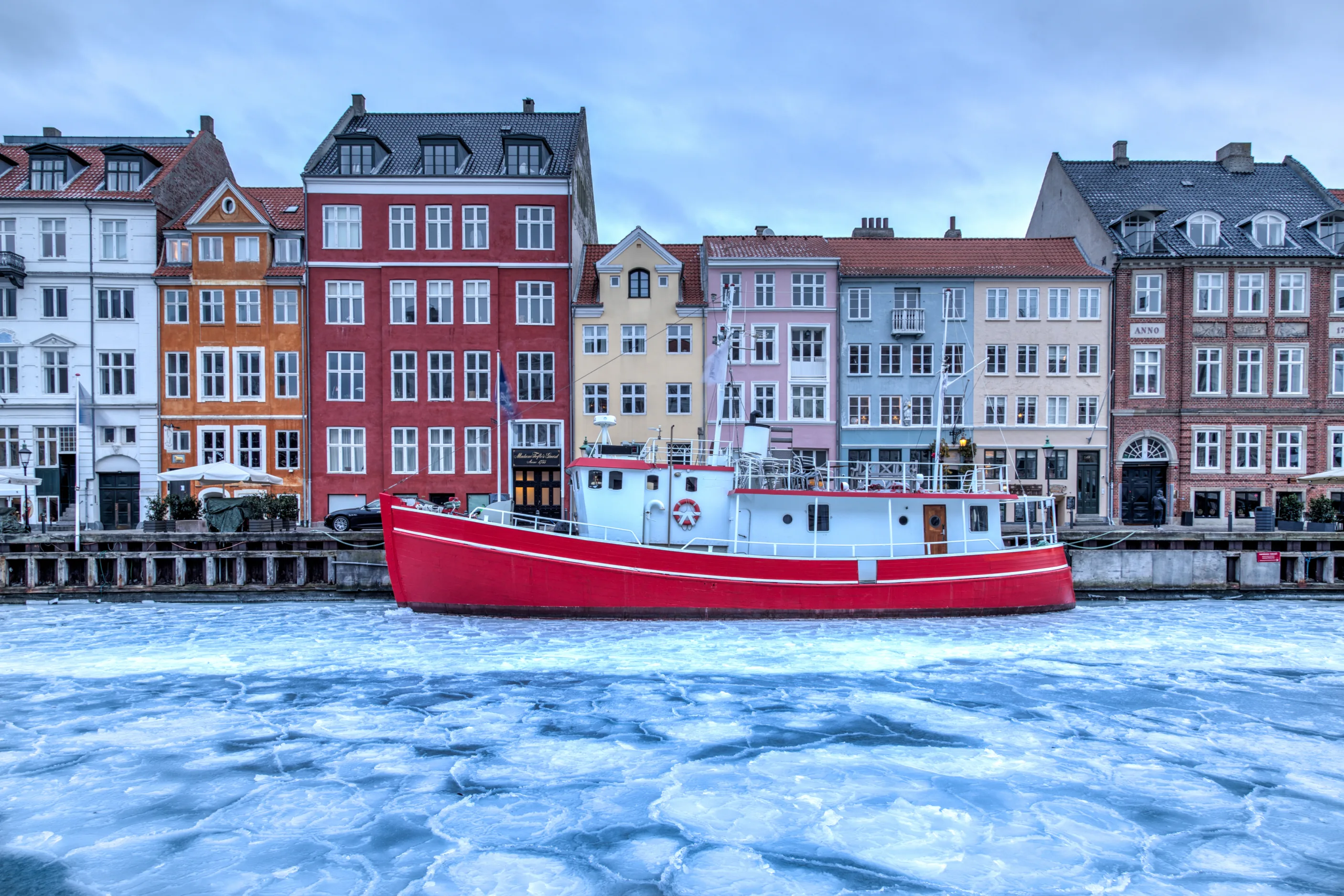
Copenhagen
Copenhagen is a port city in Scandinavia full of artsy museums, windswept castles, and hip restaurants. The city has a relaxed, homey feel. Bicycles zip in and out of leafy boulevards, past bakeries, hotdog stands, and cool cafes. People swim year-round in the pristine waters of the harbor that encircles Copenhagen like a moat around a fortress. Descended from Vikings, Danish people have a familial kinship with the sea. Day trips by train up the spectacular Øresund coast showcase the cobalt blue ocean and sweeping views across to Sweden. A few years ago, Copenhagen was birthplace to a gastronomic revolution known as the New Nordic cuisine. People now come from all over the world to dine in Copenhagen on dishes that speak to the contemporary Danish mentality; clean, simple, and appreciative of all seasons. The quality of food and life in Copenhagen is very high. Maybe it’s the sea air or the Danish eye for design, but people just seem happier in Copenhagen. After spending a day or two here, trying a Smørrebrød sandwich and maybe some aquavit schnapps, you’re bound to take some happiness away with you.

Learn About Copenhagen
Build Copenhagen Trip

Warsaw
Warsaw is a place that seems almost indestructible. Nearly bombed out of existence in World War II, the city rebuilt itself out of the rubble, and today it’s a shining example of a thriving European capital with a lot to offer. History forms a big part of Warsaw’s allure. Occupied by the Nazis, and losing much of its Jewish population to the Holocaust, Warsaw has several museums dedicated to remembering its dark past. The Warsaw Uprising Museum, POLIN Museum of the History of Polish Jews, and National Museum are among the most prominent. Although its past has been troubled, Warsaw’s present is anything but. The city contains countless opportunities for fun, with a blossoming nightlife scene and a vibrant cafe culture. After a day of wandering through the old streets and charming squares, there are plenty of places to enjoy a meal, from high-end restaurants to affordable milk bars. Warsaw is a place for reflection and remembrance, but also a place that looks firmly towards the future, a future that for this city— appears increasingly bright.

Learn About Warsaw
Build Warsaw Trip

Krakow
Krakow is a city in the south of Poland and the country’s former royal capital. Thought to have been inhabited for tens of thousands of years, the history here seems to sit comfortably alongside the vibrant, young city that is Krakow today. The main market square at Krakow’s center is overlooked by St Mary’s Basilica, a perfect example of Polish Gothic architecture and a UNESCO World Heritage Site. The square itself is usually filled with life, as the pubs and restaurants around the edges spill out onto the sidewalks. Winter is cold here, but that’s just a perfect excuse to slip inside a cozy, well-heated pub and sip hot mulled wine over a hearty Polish dinner. With all of Krakow’s heady charm, it can be easy to forget the all-too-recent atrocities that occurred in this region. A short trip to the Auschwitz-Birkenau concentration camp nearby, where the Nazis committed their genocide, provides a sober but important reminder of that past. A hard past exists alongside a happy and electric present in Krakow, a city that has endured centuries of trials and emerged looking better than ever.

Learn About Krakow
Build Krakow Trip

Prague
The city of Prague is indisputably the gem of Central Europe. Full of history, culture, and classic Czech pubs around every corner, Prague is teeming with nooks and crannies just waiting to be discovered. The narrow cobblestone streets and warm red rooftops give the city a homey feel, while the well-preserved medieval architecture transports you back in time. Walking across the Charles Bridge with the view of the Prague Castle will make you feel like you’re living in a fairytale, and you might as well be. As an up-and-coming destination, Prague is a perfect mix of classic and modern. New trendy cafes and bistros are always popping up, and you can always find a group of lively locals chowing down on goulash and quaffing pivo (the best beer in Europe!) at traditional Czech restaurants across the city. The clash of modernity and tradition, preservation and innovation, gives this city a mysterious air that you won’t soon forget.

Learn About Prague
Build Prague Trip

Budapest
Situated at the heart of Europe, Budapest is the capital of Hungary, appropriately named 'The Pearl of the Danube,' for its fixating and almost haunting beauty. Formerly two separate cities, Buda and Pest were forged into one by time, occupation, and the eight bridges that anchor them together today. From the Romans to the Communists, each occupier left its flavor profile in Budapest, evident in the famous spicy Hungarian stew known as 'goulash.' Budapest is a melting pot of history, culture, and taste, from the magnificent Baroque and neo-Gothic architecture to the Turkish thermal baths. After a long day of sightseeing, treat yourself to a glass of Tokaj, what King Louis XIV of France referred to as the "Wine of Kings, King of Wines". Budapest has a flavor to satisfy any taste.

Learn About Budapest
Build Budapest Trip

Berlin
Since the fall of its notorious wall, Berlin’s unification has seen it go from strength to strength. No wonder the city feels like it hasn’t stopped partying since the 1990s. There is so much to celebrate here. Fueled by the robust economy, a thriving tech scene, and straight-up German bonhomie, when you step into Berlin you’ll soon be caught up in its spirit. For all this gusto, Berlin hasn’t forgotten its troubled past. A visit to Berlin is to bear witness to history. Portions of the wall remain intact, and the city’s Jewish Museum offers a detailed, emotional examination of the Holocaust. Inside the reconstructed Reichstag, every attempt has been made to preserve the parliament’s beleaguered history. The buildings' glass dome addition feels less like a triumphal crown and more like a freshly healed battle scar. Days in Berlin are easily spent wandering from a cafe to the cultural institutions on Museum Island, or over to the Charlottenburg Palace. By night, crowds wander through the booming bars and nightclubs or gaze upon the floodlit Brandenburg Gate and Victory Column monuments. An international city that can offer something to everyone, Berlin is an unmissable stop on your German journey.

Learn About Berlin
Build Berlin Trip

Copenhagen
Copenhagen is a port city in Scandinavia full of artsy museums, windswept castles, and hip restaurants. The city has a relaxed, homey feel. Bicycles zip in and out of leafy boulevards, past bakeries, hotdog stands, and cool cafes. People swim year-round in the pristine waters of the harbor that encircles Copenhagen like a moat around a fortress. Descended from Vikings, Danish people have a familial kinship with the sea. Day trips by train up the spectacular Øresund coast showcase the cobalt blue ocean and sweeping views across to Sweden. A few years ago, Copenhagen was birthplace to a gastronomic revolution known as the New Nordic cuisine. People now come from all over the world to dine in Copenhagen on dishes that speak to the contemporary Danish mentality; clean, simple, and appreciative of all seasons. The quality of food and life in Copenhagen is very high. Maybe it’s the sea air or the Danish eye for design, but people just seem happier in Copenhagen. After spending a day or two here, trying a Smørrebrød sandwich and maybe some aquavit schnapps, you’re bound to take some happiness away with you.

Learn About Copenhagen
Build Copenhagen Trip

Warsaw
Warsaw is a place that seems almost indestructible. Nearly bombed out of existence in World War II, the city rebuilt itself out of the rubble, and today it’s a shining example of a thriving European capital with a lot to offer. History forms a big part of Warsaw’s allure. Occupied by the Nazis, and losing much of its Jewish population to the Holocaust, Warsaw has several museums dedicated to remembering its dark past. The Warsaw Uprising Museum, POLIN Museum of the History of Polish Jews, and National Museum are among the most prominent. Although its past has been troubled, Warsaw’s present is anything but. The city contains countless opportunities for fun, with a blossoming nightlife scene and a vibrant cafe culture. After a day of wandering through the old streets and charming squares, there are plenty of places to enjoy a meal, from high-end restaurants to affordable milk bars. Warsaw is a place for reflection and remembrance, but also a place that looks firmly towards the future, a future that for this city— appears increasingly bright.

Learn About Warsaw
Build Warsaw Trip

Krakow
Krakow is a city in the south of Poland and the country’s former royal capital. Thought to have been inhabited for tens of thousands of years, the history here seems to sit comfortably alongside the vibrant, young city that is Krakow today. The main market square at Krakow’s center is overlooked by St Mary’s Basilica, a perfect example of Polish Gothic architecture and a UNESCO World Heritage Site. The square itself is usually filled with life, as the pubs and restaurants around the edges spill out onto the sidewalks. Winter is cold here, but that’s just a perfect excuse to slip inside a cozy, well-heated pub and sip hot mulled wine over a hearty Polish dinner. With all of Krakow’s heady charm, it can be easy to forget the all-too-recent atrocities that occurred in this region. A short trip to the Auschwitz-Birkenau concentration camp nearby, where the Nazis committed their genocide, provides a sober but important reminder of that past. A hard past exists alongside a happy and electric present in Krakow, a city that has endured centuries of trials and emerged looking better than ever.

Learn About Krakow
Build Krakow Trip

Prague
The city of Prague is indisputably the gem of Central Europe. Full of history, culture, and classic Czech pubs around every corner, Prague is teeming with nooks and crannies just waiting to be discovered. The narrow cobblestone streets and warm red rooftops give the city a homey feel, while the well-preserved medieval architecture transports you back in time. Walking across the Charles Bridge with the view of the Prague Castle will make you feel like you’re living in a fairytale, and you might as well be. As an up-and-coming destination, Prague is a perfect mix of classic and modern. New trendy cafes and bistros are always popping up, and you can always find a group of lively locals chowing down on goulash and quaffing pivo (the best beer in Europe!) at traditional Czech restaurants across the city. The clash of modernity and tradition, preservation and innovation, gives this city a mysterious air that you won’t soon forget.

Learn About Prague
Build Prague Trip
prev
next


 Map of Your Itinerary Route
Map of Your Itinerary Route
Zoom In to the cities to see your itinerary in more detail


 4.8
4.8 
